 |
PO Box 9021,
Wilmington, DE 19809, USA
E-mail: font@focusonnature.com
Phone: Toll-free in USA 1-888-721-3555
or 302/529-1876 |
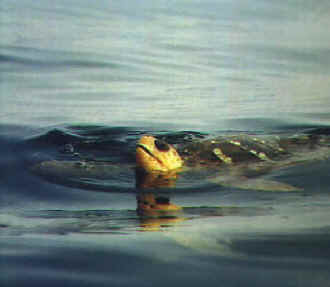 MARINE LIFE
MARINE LIFE
of the Caribbean
including Sea Turtles, Fish,
Corals and Jellyfish, Mollusks (Shells),
Arthropods (Crustaceans
and Echinoderms)
and more
Not including here the
Whales, Dolphins and Manatee
A list of Caribbean Marine Life compiled by Armas Hill
Noting those seen during Focus On Nature Tours and pelagic trips
with an (*)
There are 432 species of various marine creatures in this
list.
Photo at upper right:
LOGGERHEAD TURTLE photographed during a FONT Tour
(photo by Alan Brady)
Codes:
CY: Cayman Islands
DM: Dominica
HS: Hispaniola (where there have
been FONT tours in the Dominican Republic)
JM: Jamaica
PR: Puerto Rico
SL: Saint Lucia
(p): seen pelagically
Classifications as designated by IUCN (International Union for the Conservation of
Nature) relating to threatened species:
(t1): critically endangered
(t2); endangered
(t3): vulnerable
(nt): near-threatened
(ph): species with a photo in the FONT website
(AS:xx) refers to
plate number of photo in the "National Audubon Society Field Guide to
North American Seashells"
(ASC:xx)
refers to plate number of photo in
the "National Audubon Society Field Guide to Seashore Creatures"
(ATMF:xx) refers to plate number of photo in the "National
Audubon Society Field Guide to Tropical Marine Fishes"
(FGCF:xx) refers to the page with an
illustration in the book "A Field Guide to Coastal Fishes, from Maine to
Texas" by Val Kells and Kent Carpenter, 2011
(PAS:xx) refers to the plate with an
illustration in the "Peterson Field Guide, Atlantic Seashore", by
Kenneth Gosner, 1978
(PCR:xx) refers to the plate with an
illustration in the "Peterson Field Guide, Coral Reefs of the Caribbean
and Florida", by Eugene Kaplan, 1982
(PS:xx) refers to the plate with an
illustration in the "Peterson Field Guide, Shells of the Atlantic and
Gulf Coasts and the West Indies", by R. Tucker Abbott and Percy Morris,
1995
Links, in the following list, to:
Sea
Turtles Fish
INVERTEBRATES
Planktonic
creatures Sponges
Segmented Worms
Corals
Sea Anemones
Jellyfish Hydroids
& Siphonophores Ctenophores:
Comb Jellies
MOLLUSKS
(Shells) CHITONS
GASTROPODS: Keyhole Limpets Periwinkles Turret Shells
Sundial Horn Shells
Ceriths Conch Trivia Cowries
Simnia Helmet Shells Triton
Murex Shells Rock Shell
Dove
Shells Nassa Mud Snails Tulip
Shells Olive Shells
Miter Shell Nutmeg Marginella
Cone Shells Auger Shell
Turret
Shell Bubble Shell
Sea Hares
BIVALVES
Mussels Purse Shells
Pearl Oysters Pen
Shells Scallops File
Shells Oysters
Jingle Shells
CEPHALOPODS:
Squids Octopuses
ARTHROPODS:
including Crustaceans & Echinoderms Shrimps
& Lobsters Crabs
Sea
Stars
Brittle Stars Sea Urchins, Sea Biscuits, Sand Dollars
Sea Cucumbers Sea Lilies or Feather Stars
Other Links:
Mammals in the West Indies of the Caribbean
(including marine mammals: whales, dolphins, and manatee)
A List & Photo Gallery of Caribbean birds, in 2 Parts
Butterflies & Moths in the West Indies of the Caribbean
(some
some photos)
Amphibians & Reptiles in the West Indies of the Caribbean
(with some
photos)
Marine Life of eastern Mexico, Belize, & Honduras
Marine Life of the Southeast US
A
Listing of scheduled Focus On Nature Tours
Upcoming
Focus On Nature Tours in the Caribbean
FONT
Past Tour Highlights

MARINE, or SEA, TURTLES
- Leatherback (Sea Turtle) (t1) (ph) ______ SL
Dermochelys coriacea (the single member of its genus)
The Leatherback is the world's largest turtle. It can weigh half a
ton. It is a deep diver. It can go to a depth of about 5,000 feet.
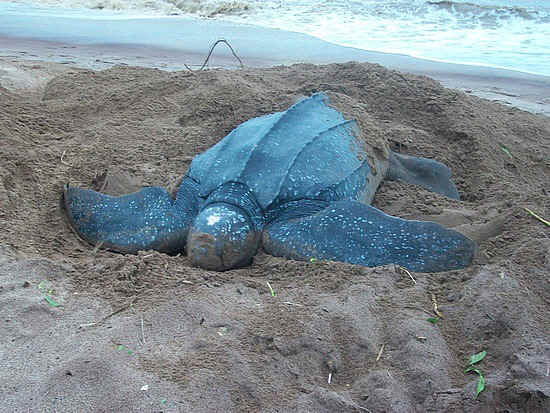
A female Leatherback Sea Turtle on a beach in
the Caribbean laying her eggs
- Loggerhead (Sea Turtle) (t2) (ph) (*) ______
PR
Caretta caretta
(the single ember of its
genus)
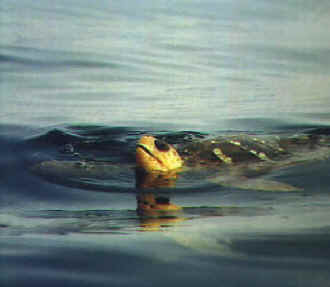
Loggerhead Sea Turtle
(photo by Alan Brady during a FONT tour)
- Green (Sea) Turtle (t2) (ph) (*) ______ DM
Chelonia mydas
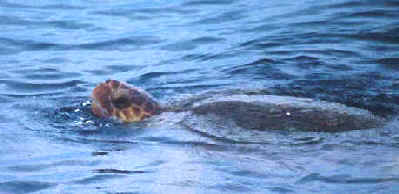
A Green Sea Turtle photographed during a FONT tour in Dominica
- Hawksbill (Sea Turtle) (t1) (ph) (*)
______ PR
Eretmochelys imbricata
(the single member of its genus)
The Hawksbill (Sea Turtle) favors, among other places, coral reefs. It has a
varied diet.
It has a long beak and two pairs of prefrontals.
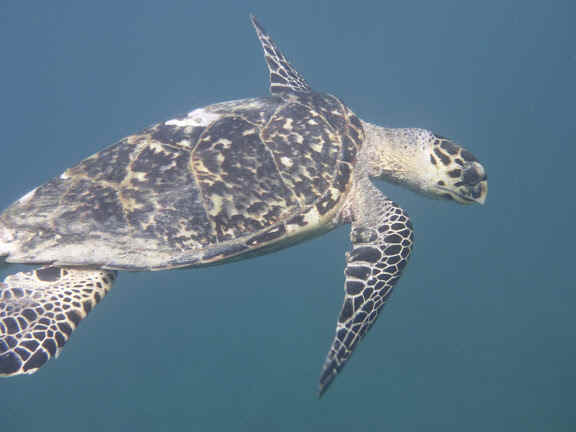
Hawksbill Sea Turtle
(photo courtesy of Diane Allison)
- Kemp's Ridley (Sea) Turtle (t1) ______
Lepidochelys kempii
The Kemp's Ridley is said to be the world's rarest sea turtle; It is
classified as "critically endangered".
- Olive Ridley (Sea) Turtle ______
Lepidochelys olivacea
An excellent book about Sea Turtles is "Voyage of the Turtle - In
Pursuit of the Earth's Last Dinosaur", by Carl Safina, Owl Books,
2007.
FISH
Click the
above link to a list of fish of the Caribbean: 695 species
OCEANIC
INVERTEBRATES
PLANKTONIC CRATURES (Phyllum
Dinoflagellata)
- Dinoflagellates ______ JM
PR
Dinoflagellates are microorganisms that glow in where fresh and salt
water meet. They can be a spectacle after dark, but at only a very few
places in the world - it is said at 3 or 4 such places.
One such place, where we have enjoyed seeing this phenomenon during FONT
tours, has been in the area of Falmouth, Jamaica, where the Martha Brae
River meets the sea.
There are 3 bioluminescent bays (or "bio bays") in Puerto Rico,
where we have visited, during FONT tours, the one in the southwestern part
of the island at La Parguera.
SPONGES (Phyllum
Porifera)
All of the sponges that follow
here are in the Class DEMOSPONGIAE.
- Red Sponge ______
(ASC:31) West Indies, also Florida to Texas
Haliclona rubens
- Loggerhead Sponge ______
(ASC:17) West Indies including Bahamas, also North
Carolina to Florida and Mexico
Spheciospongia vesparia
Spheciospongia vesparia is
the larges sponge known, up to 36 inches wide and 24 inches high.
As many as 16,000 animals, most of them snapping shrimp, have been
recorded in the canal system of one specimen.
Spheciospongia vesparia has shared
the same common name as an unrelated sponge, Ircinia
strobilina (below).
- Loggerhead Sponge (or
Cake Sponge) ______ (ASC:18)
West Indies including Bahamas, also Florida to Mexico
Ircinia strobilina
To avoid confusion with Speheciospongia
vesparia (above), for Ircinia
strobilina the name "Cake Sponge" could be
an alternative.
- Stinker Sponge ______ (ASC:22)
West Indies including Bahamas, also Florida to Mexico
Ircinia fasciculata
Most sponges have an unpleasant smell, but the Stinker Sponge
emits an especially repulsive odor.
Ircinia fasciculata is resilient
when alive, but it becomes hard and brittle when dried. It commonly is found
washed ashore after storms.
- Vase Sponge ______ (ASC:19,21)
West Indies including Bahamas, also Florida to Mexico
Ircinia campana
- Sheep's Wool Sponge
______ West Indies including Bahamas, also Florida to Mexico
Hippiospongia lachne
The name Sheep's Wool Sponge comes from its softness after
cleaning.
It has been the most important commercial sponge in the New World, once
providing a thriving industry in the areas of the Caribbean and Gulf of
Mexico.
But the industry could not compete with new synthetic cellulose sponges, and
today natural sponges are sold chiefly to tourists.
- Do-not-touch-me Sponge ______ (ASC:22)
West Indies including Bahamas, also Florida to Mexico
Neofibularia nolitangere
The Do-not-touch-me Sponge is so-named for a reason.
It is highly toxic, causing severe blisters if handled.
As another stinging sponge, the Fire Sponge (below), is also
red, it is prudent to avoid touching any red sponge in subtropical waters.
- Fire Sponge ______
(ASC:129) West Indies including Bahamas, also Florida
to Mexico
Tedania ignis
As noted, the Fire Sponge is highly toxic,
causing severe blistering and pain if touched with bare hands.
- Tube Sponge ______ (ASC:23)
West Indies including Bahamas, also Florida to Mexico
Callyspongia vaginalis
Brittle Stars and Basket Stars (in the Class STELLEROIDEA)
commonly hide in the handsomely colored pipes of the Tube Sponge, or
they perch atop them while feeding.
- White Sponge ______
(ASC:15) West Indies including Bahamas, also Florida
to Mexico
Geodia gibberosa
Due to the whiteness of Geodia gibberosa, and its prevalence in turtle
grass beds, it is easily found and identified.
- Chicken Liver Sponge ______
(ASC:24) West Indies including Bahamas, also Florida
to Mexico
Chondrilla nucula
The slick surface of Chondrilla nucula,
and its shape, size, and color are reminiscent of chicken liver.
SEGMENTED
WORMS (Phyllum Annelida)
A coral reef can transform its inhabitants from
more mundane terrestrial creatures into those that are colorful and
flamboyant.
That transformation is no where more apparent than it is with the ANNELIDS,
or SEGMENTED WORMS.
On a reef, these worms look like flowers in a garden, colorful fans, and
miniature Christmas trees.
- Horned Christmas Tree Worm (or
Feathered Christmas Tree Worm) ______ throughout
the West Indies
Spirobranchus giganteus giganteus
- Star Christmas Tree Worm
______
Pomatostegus stellatus
Spiny Feather Duster Worms (ph) ______
There are 10 to 15 of these species in the Hydroides
genus throughout the Caribbean.
Those that are common include the following:
- Hydroides crucigera
______
- Hydroides elegans
______
- Hydroides
unicinata ______
Accurate species identification requires detailed study of operculum and
setae.
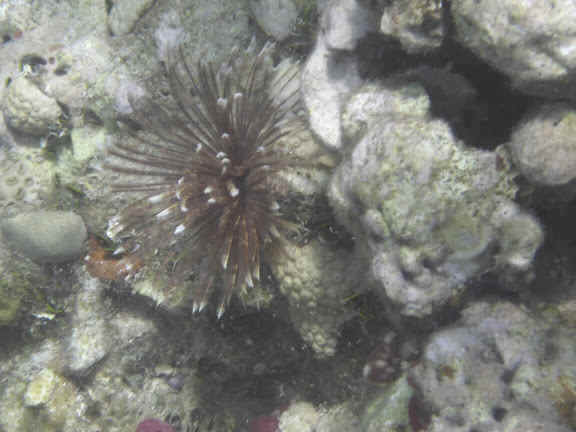
Feather Duster
(photo courtesy of Diane Allison)
CNIDARIANS (including CORALS
and JELLYFISH)
REEF CORAL
(Class Anthozoa)
HARD CORALS
- Staghorn Coral ______ (ASC:55)
(PCR:7)
Acropora cervicornis
- Elkhorn Coral
______ (ASC:32)
(PCR:7)
Acropora palmata
- Tan Lettuce-leaf Coral ______
(PCR:11)
Agaricia agaricites
- Lamarack's Lettuce-leaf Coral
______ (PCR:11)
Agaricia lamarchi
The Lamarack's Lettuce-leaf Coral is in water deeper than 8 meters, or 27
feet.
- Lettuce Coral ______ (ASC:33)
Agaricia tenuifolia
Agaricia tenuifolia
is also called Thin Leaf Coral.
- Sunray Lettuce-leaf Coral
______ (PCR:11)
Helioseris cucullata
The Sunray Lettuce-leaf Coral is in water deeper than 8 meters, or 27 feet.
- Tube Coral ______ (PCR:7)
Cladocora arbuscula
- Scarlet Coral ______
(ASC:16) (PCR:10)
Siderastrea radians
Another name for Siderastrea radians is
Shallow-water Starlet Coral.
- Reef Scarlet Coral ______
(ASC:14) (PCR:10)
Siderastrea siderea
Another name for Siderastrea siderea is
Round Starlet Coral.
- Red Coral (or Orange
Coral)
______ (PCR:10)
Tubastrea coccinea
- Large Star Coral
______ (ASC:11,174)
Montastrea cavernosa
- Common Star Coral ______ (ASC:10)
(PCR:8)
Montastrea annularis
Montastrea annularis
is also called Boulder Star Coral, or Boulder Coral. It is
the most common coral in the Caribbean.
- Large-cupped Boulder Coral
______ (PCR:8)
Montastrea cavernosa
- Yellow Porous Coral ______
(ASC:9) (PCR:8)
Porites astreoides
Porites astreoides
is also called Finger Coral.
- Thin Finger Coral ______
(PCR:7)
Porites furcata
- Clubbed Finger Coral ______
(ASC:13) (PCR:7)
Porites porites
Porites porites
is also called Thick Finger Coral.
- Common Brain Coral (ph) ______ (ASC:2) (PCR:9)
Diploria strigosa
Other names for Diploria strigosa
are Smooth Coral and Symmetrical Brain Coral.
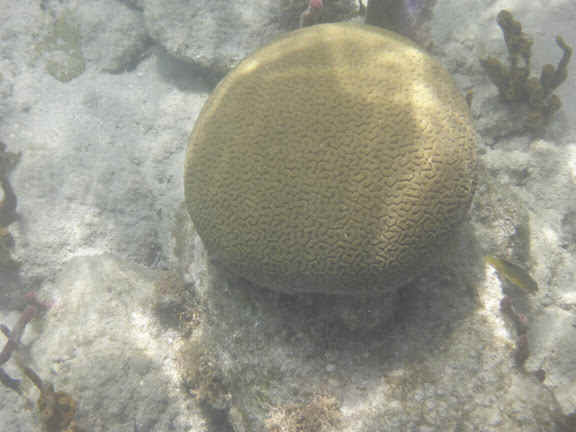
Brain Coral
(photo courtesy of Diane Allison)
- Knobbed Brain Coral ______ (ASC:4)
(PCR:9)
Diploria clivosa
Another name for Diploria clivosa is
Sharp-billed Brain Coral.
- Labyrinthine Brain Coral ______
(ASC:3) (PCR:9)
Diploria labyrinthiformis
Another name for Diploria labyrinthiformis is
Depressed Brain Coral.
- Large Grooved Brain Coral
______ (PCR:9)
Colpophyllia natans
- Common Rose Coral ______
(ASC:175) (PCR:9)
Manicina areolata
- Ivory Bush Coral ______ (ASC:35)
(PCR:7)
Oculina diffusa
- Oculina valenciennesi
______
- Meandrine Brain Coral ______ (ASC:5)
(PCR:9)
Meandrina meandrina
Another name for Meandrina meandrina is Tan Brain Coral.
- Stokes' Star Coral ______
(ASC:7) (PCR:10)
Dichocoenia stokesii
Dichocoenia stokesii
is also called Stokes' Starlet Coral.
- Pillar Coral (ph) ______
(ASC:6) (PCR:7)
Dendrogyra cylindrus
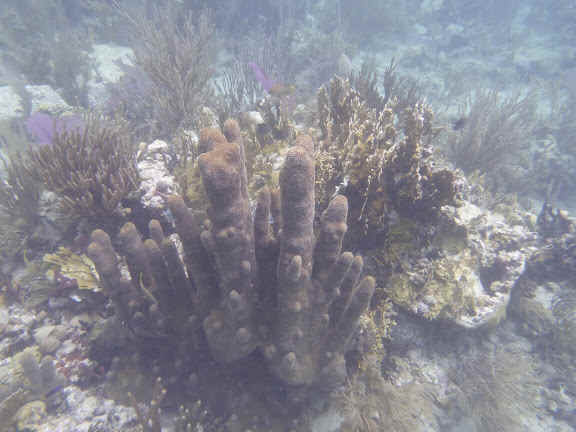
Pillar Coral
(photo courtesy of Diane Allison)
- Flower Coral ______
(ASC:173,198) (PCR:10)
Eusmilia fastigiata
Flower Coral is often at the bases of brain and boulder corals.
- Large Flower Coral
______ (ASC:1) (PCR:10)
Mussa angulosa
- Star Coral ______ (PCR:10)
Favia frogum
- Rough Star Coral
______ (PCR:8)
Isophyllastrea rigida
- Cactus Coral
______ (PCR:8)
Isophyllia sinuosa (form multiflora)
Isophyllia sinuosa (form sinuosa) ______ Stalked Cactus
Coral (PCR:8)
- Branching Coral
______ (PCR:7)
Madracis mirabilis
- Crenelated Fire
Coral ______ (PCR:11)
Millepora alcicornis
- Flat-topped Fire
Coral ______ (PCR:11)
Millepora complanata
- Encrusting Fire
Coral ______
Millepora squarrosa
- Large Cactus Coral
______ (PCR:8)
Mycetophyllia lamarckiana
- Large-cupped Fungus
Coral ______ (PCR:10)
Scolymia lacera
SOFT CORALS
- Corky Sea Fingers ______ (ASC:68)
(PCR:12,13)
Briareum asbestinum
Another name for Briareum asbestinum is
Deadman's Fingers.
- Brown Encrusting Soft Coral
______
Erythropodium caribaeorum
- White Encrusting Sort Corals ______
Telesto spp.
- Telesto riisei
______ the most common species of
Telesto
The Caribbean Sea has numerous species of soft corals
called GORGONIANS - including SEA PLUMES
or SEA FEATHERS, SEA FANS, SEA BLADES, and SEA WHIPS.
The SEA WHIP in the photo below was photographed in the Virgin Islands, in
St. John.
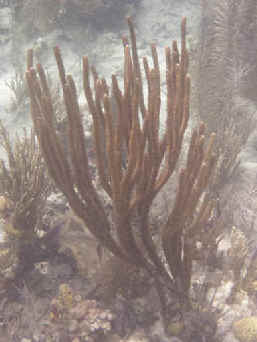
Sea Whip
(photo courtesy of Diane Allison)
- Sea Plumes (or Sea
Feathers) ______ (ASC:60.66)
(PCR:12,13,18)
Pseudopterogorgia spp.
There are 12 species of Sea Feathers in the Caribbean, mostly
difficult to identify. They include the following:
- Forked Sea Feather ______
Pseudopterogorgia bipinnata
- Deepwater Sea Feather ______
Pseudopterogorgia elizabethae
- Slimy Sea Feather ______
Pseudopterogorgia americana
- Smooth Sea Feather ______
Pseudopterogorgia acerosa
- Sea Blades ______
(PCR:30)
Pterogorgia spp.
- Guadeloupe Sea Blade
______
Pterogorgia guadellupensis
- Purple Sea Blade (or
Angular Sea Whip) ______
Pterogorgia anceps
- Yellow Sea Blade (or
Yellow Sea Whip) ______ (ASC:59,62)
Pterogorgia citrina
- Sea Fans ______ (PCR:18)
Gorgonia spp.
- Common Sea Fan ______
Gorgonia ventalina
- Purple Bush Sea Fan (or
Purple Plume Gorgonia) ______ (PCR:13)
Muriceopsis flavida
- Spiny Muricea ______ (ASC:61)
(PCR:12,13)
Muricea muricata
The Spiny Muricea, and the following 3 species are also known as Spiny
Candelabras.
-
Muricea atlantica ______
- Muricea elongata
______
- Muricea laxa
______
- Common Bushy Soft
Coral ______ (ASC:57) (PCR:12)
Plexaura homomalla
Another name for Plexaura homomalla is Black Sea Rod.
- Tan Bushy Soft Coral ______ (PCR:12)
Plexaura flexuosa
Another name for Plexaura flexuosa is Bent Sea Rod.
- Sea Rods ______ (PCR:13)
Plexaurella spp. (about 6 species)
- Double-forked Plexaurella
______ (ASC:58)
Plexaurella dichotoma
- False Plexaurellas ______
(PCR:13)
Pseudoplexaura
sp.
- Eunicea Sea Rods ______ (ASC:56)
(PCR:12,13)
Eunicea spp.
Eunicea
species are also called Knobby Candelabras.
Three Eunicea species follow:
- Eunicea mammosa
______
- Eunicea succinea
______
- Tournefort's Knobby
Candelabrum ______
Eunicea tourneforti
- Common Sea Pansy ______ (PAS:11)
Renilla reniformis
The Common Sea Pansy is common in some shallow-water areas. it looks like a
flat-topped mushroom with polyps growing from the upper surface.
SEA ANEMONES
(Class Anthozoa)
COLONIAL ANEMONES
- Mat Anemone ______
(ASC:12)
Zoanthus pulchellus
- Green Colonial
Anemone ______ (PCR:14)
Zoanthus sociatus
- Zoanthus solanderi
______
- Encrusting Colonial Anemone
______ (PCR:14)
Palythoa caribaeorum
- Knobbed Colonial Anemone ______ (ASC:8)
Palythoa mammillosa
Another name for Palythoa mammillosa is
Knobbed Zoanthidean.
- Symbiotic Colonial
Anemones ______ (PCR:19)
Parazoanthus spp.
Symbiotic Colonial Anemones live on sponges. They are small, up to
one-fourth of an inch in diameter and height.
- Parazoanthus swiftii
______
- Parazoanthus parasiticus
______ (PCR:19)
-
Parazoanthus puertoricense ______
TRUE ANEMONES
- Maroon Anemone
______ (PCR:15)
Actinia bermudensis
- Sargassum Anemone
______
Anemone sargassiensis
- Rock Anemone
______ (PCR:14)
Anthopleura krebsi
- Pink-tipped Anemone ______
(ASC:187,188)
Condylactis gigantea
- Warty Sea Anemone ______
(ASC:193)
Bunodosoma cavernata
- Red Warty Anemone
______ (PCR:14)
Bunodosoma granuliferum
- Collared Sand
Anemone ______ (PCR:14)
Phyllactis flosculifera
- Speckled Anemone ______
(ASC:189,192) (PCR:15)
Phymanthus crucifer
Another name for Phymanthus crucifer is Beaded Anemone.
- Tricolor Anemone ______
(ASC:194) (PCR:15)
Calliactis tricolor
-
Aiptasia pallida ______
(ASC:167)
- Pale Anemone
______ (PCR:14)
Aiptasia tagetes
- Ringed Anemone ______ (ASC:190)
(PCR:15)
Bartholomea annulata
- Giant Caribbean
Anemone ______ (PCR:15,18,30)
Condylactis gigantea
- Stinging Anemone
______ (PCR:15)
Lebrunia danae
- Sun Anemone
______ (PCR:15)
Stoichactis helianthus
FALSE CORALS
- Umbrella False
Coral ______
Paradiscoma neglecta
- St. Thomas False
Coral ______ (PCR:14)
Rhodactis sanctithomae
- Florida False
Coral ______ (PCR:14)
Ricordia florida
TUBE-DWELLING ANEMONES
- Banded Tube-dwelling
Anemone ______ (PCR:15)
Arachnanthus nocturnus
- American Tube-dwelling
Anemone ______
Ceriantheopsis americanus
JELLYFISH (Class Scyphozoa)
- Crown Jellyfish ______ (ASC:503)
Nausithoe punctata
- Purple Jellyfish ______
(ASC:508)
Pelagica noctiluca
- Moon Jellyfish (ph) ______ (ASC:502) (PCR:16)
Aurelia aurita
The Moon Jellyfish is mildly
toxic.
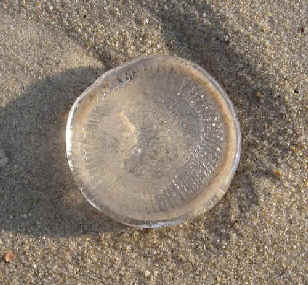
Moon Jellyfish
Above on a beach; below in the water
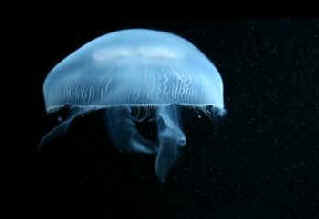
- Upside-down Jellyfish (ph) ______ (ASC:509) (PCR:16)
Cassiopeia xamachana
The Upside-down Jellyfish is mildly toxic.
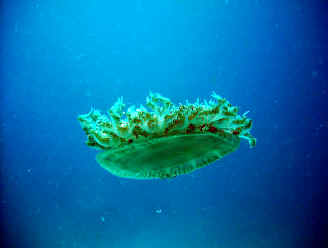
Upside-down Jellyfish
- Cannonball Jellyfish ______ (ASC:507,514)
(PCR:16)
Stomolophus meleagris
- Caribbean Cubomedusae (or
Sea Wasps) ______
(PCR:16)
in Chiropsalmus, and other related genera
such as Carybdea
"Sea Wasps" are
small, transparent jellyfish, about the size and shape of a small match box.
They have one tentacle on each corner of their body.
The name "Cubomedusae" is due to the body shape (like a
cube). The creature is related to the deadly Cubomedusae off
Australia. Fortunately, the Caribbean variety is not deadly, but it will
impart a strong sting.
These animals usually live in deep water, but they rise to the surface in
the daytime. They are not, however, very common. A snorkeler or diver is
generally not likely to encounter these jellyfish.
- Sea Nettle ______
(PCR:16)
Chrysaora
quinquecirrha
HYDROIDS
and SIPHONOPHORES (Class
Hydrozoa): not "true" jellyfish
- Feathered Hydroid ______ (ASC:86)
West Indies, also Maine to Florida and Texas
Pennaria tiarella
- Bougainvillia Hydroids ______ (ASC:80)
Bougainvillia spp.
- Stick Hydroid ______
(ASC:82)
Eudendrium ramosum
- Many-ribbed Hydromedusa ______
(ASC:500)
Aequorea aequorea
- Wine-glass Hydroids ______
(ASC:75,77)
Campanularia spp.
- Zig-zag Wine-glass Hydroid ______
(ASC:78)
Obelia geniculata
- Tropical Garland Hydroid ______
(ASC:70)
Sertularella speciosa
- Feathery Hydroids ______ (ASC:67,69)
Aglaophenia spp.
- Portuguese Man-of-war (ph) ______ (ASC:512,513)
(PCR:30)
Physalia physalis
The Portuguese Man-of-war is a common siphonophore occurring at the sea
surface. Gas-filled, its clear blue float and pink crest are unmistakable.
Its long, blue, coiled stinging tentacles are up to over 10 meters in
length, hanging below a blue to purple-colored colony.
Also known by the name "bluebottles".
The float is up to 30 centimeters long, and has a crest which acts as a
sail. It is blown along by wind and carried by currents. Shows
"tumbling" behavior when it dips each side alternately in the
water, so keeping the float moist.
Highly toxic. Can deliver a painful sting.
The Bluebottlefish, Nomeus gronovii, is often found in association with
Physalia.
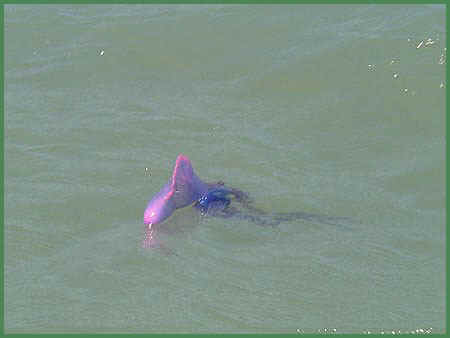
Portuguese Man-of-War
- Blue Button ______
(PCR:16)
Porpita porpita
- By-the-wind Sailor ______
(PCR:16)
Velella velella
- Fire Coral ______ (ASC:25)
Millepora alcicornis
The Fire Coral is highly toxic.
CTENOPHORES: COMB
JELLIES (Phylum CTENOPHORA)
- Beroe's Comb Jellies
______
Beroe sp.
- Venus' Girdle ______
Cestum veneris
- Sea Walnuts (or Lobate Com
Jellies) ______ (PCR:28)
Mnemiopsis sp.
MOLLUSKS (SHELLS)
SEASHELLS are made by MOLLUSKS.
MOLLUSKS are invertebrate animals that produce shells of one or two
pieces that wholly or partially enclose a soft body.
SHELLS are the skeletons of MOLLUSKS. Like the internal
skeleton (endoskeleton) of a mammal, the external skeleton (exoskeleton) of
mollusks function both for protection and as a place for muscle
attachment.
A SHELL found on a beach is the skeletal remnant of a dead MOLLUSK.
MOLLUSKS are either snail-like animals with one shell (UNIVALVES,
or GASTROPODS), or clam-like animals with two shells (BIVALVES).
The two shells of a BIVALVE are held tightly together when the animal
is alive.
A third group of MOLLUSKS are the CEPHALOPODS, including SQUIDS
and OCTOPUSES. These animals lack external shells, having instead
internal or rudimentary shells.
CHITONS (Class
Polyplacophora)
- Rough-girdled Chiton ______
(ASC:375) West Indies including Bahamas, also Florida
Ceratozona squalida
- Mesh-pitted Chiton ______
West Indies including Bahamas, also Florida to Texas
Ischnochiton papillosus
- Florida Slender Chiton ______
(ASC:378) West Indies including Bahamas, also southeast Florida
Stenoplax floridana
GASTROPODS (Class Gastropoda): snail-like mollusks with a one-part
shell
KEYHOLE LIMPETS
- Cayenne Keyhole Limpet ______
(ASC:384) West Indies, including Bahamas, also Virginia to
Florida and Texas
Diodora cayenensis
- Atlantic Barbados
Keyhole Limpet ______
Fissurella barbadensis
- Bleeding Tooth (ph) ______
West Indies, also south Florida
Nerita peloronta
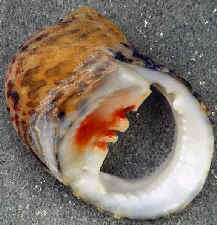
Bleeding Tooth
- Checkered Nerita
______ West Indies, also Florida to Texas
Nerita tessellata
PERIWINKLES
- Zebra Periwinkle ______
West Indies, also Florida and Gulf of Mexico
Littorina ziczac
- Angulate
Periwinkle ______ West Indies including Bahamas, also
southern Florida, Bermuda
Littorina angulifera
TURRET
SHELLS (and WORM SHELLS)
- Boring Turret Snail ______
(ASC:399) West Indies, also North Carolina to Florida and Texas
Turritella acropora
- Variegated Turret
Snail ______ West Indies including Bahamas, also south
Florida
Turritella variegata
- Common Worm Snail ______ (ASC:475)
West indies, also Massachusetts to Florida
Vermicularia spirata
SUNDIAL
- Common Sundial ______ (ASC:433)
West Indies, also North Carolina to Florida and Texas
Architectonica nobilis
HORN SHELLS
- Costate Horn Snail ______
(ASC:396) West Indies, also Florida
Cerithidea costata
- Ladder Horn Snail
______ West Indies, also South Carolina to Florida
Cerithidea scalariformis
- Black Horn Snail ______
(ASC:401) West Indies, also south Florida
Batillaria minima
CERITHS
- Lettered Cerith ______
West Indies including Bahamas, also Florida
Cerithium literatum
- Ivory Cerith
______ West Indies including Bahamas, also Florida
Cerithium eburneum
- Dwarf Cerith ______ West
Indies, also Florida
Cerithium variabile
CONCH
- Queen Conch (ph) ______
(ASC:435) West Indies, also south Florida
Strombus gigas
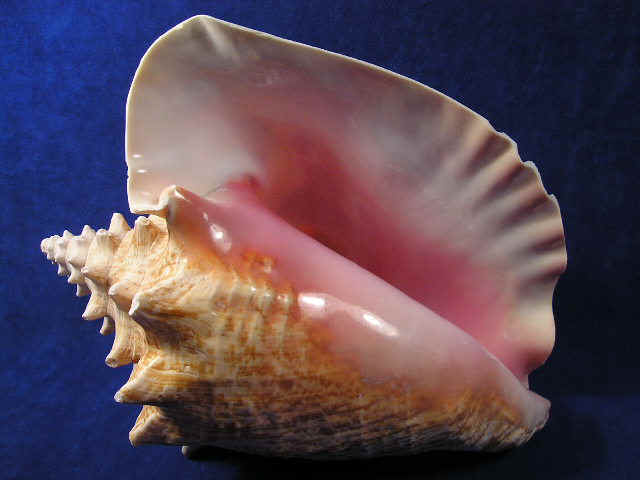
Above & below: the Queen Conch
In the lower photo, in the sea.
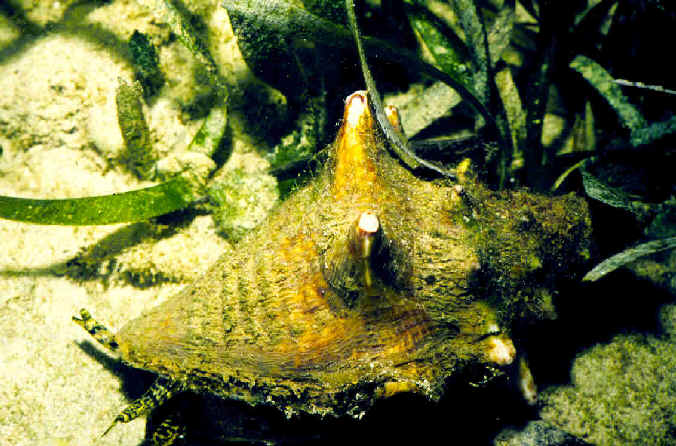
TRIVIA
- Four-spotted Trivia ______
(ASC:450) West Indies, also south Florida
Trivia quadripunctata
COWRIES
- Atlantic Gray Cowrie ______
West Indies, also southeast Florida
Cypraea spadicea
- Atlantic Deer Cowrie ______
West Indies, also southern Florida, Texas
Cypraea cervus
SIMNIA
- Flamingo Tongue (ph) ______
(ASC:449) West Indies, also North Carolina to Florida
Cyphoma gibbosum
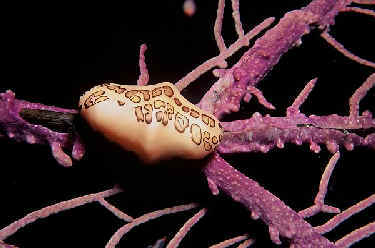
Flamingo Tongue
BABY'S EAR
- Common Baby's Ear ______
(ASC:465) West Indies, also Virginia to Florida and Texas
Sinum perspectivum
HELMET SHELLS
- King Helmet ______ (AS:7,700)
from the Caribbean north to North Carolina, south to Brazil
Cassis tuberosa
Cassis tuberosa
is common in the West Indies. In fact, it is the most common of the
true helmets in the Caribbean.
It feeds on several kinds of sea urchins and heart urchins.
- Emperor Helmet (ph) ______
(AS:8)
(ASC:434) West indies, also southeast Florida
Cassis madagascariensis
Cassis madagascariensis is
also known as the Giant Queen Helmet, or simply the Queen
Helmet.
The geographical reference in
the scientific name is a misnomer. The shell does not occur there. A good
place to see it is the US Virgin Island of St. John.
The Emperor Helmet is among the largest species of helmet shells
living today. It can reach up to 14 inches in length. It occurs in
water as shallow as 2 feet, however it can be mush deeper. The maximum
recorded depth is about 550
feet.
Groups of Emperor Helmets can sometimes be found plowing through sand
to find the heart urchins on which they feed.
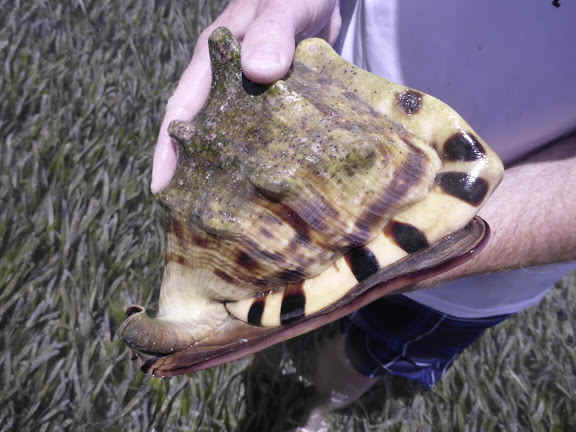
Emperor Helmet
(photo courtesy of Diane Allison)
A more rounded form of Cassis
madagascariensis with smaller and more numerous spines,
occurring off the shores of the southeast US, has been said to be a distinct
subspecies, the Clench's Helmet, Cassis
madagascariensis spinella.
It is now, however, considered to be form of the typical Emperor, or
Queen Helmet.
- Flame Helmet ______
(AS:9) from the Caribbean ranges north to the Florida
Keys, and south to Brazil
Cassis flammea
Cassis flammea is a large,
handsome shell. It is also called the Princess Helmet.
- Scotch Bonnet (ph) ______
(ASC:454) West Indies, also North Carolina south to Florida,
Texas, and Brazil
Phalium granulatum
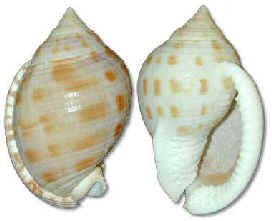
Scotch Bonnet
TRITON
- Angular Triton ______
(ASC:419) West Indies, also southeast Florida, Bermuda
Cymatium femorale
MUREX SHELLS
- Apple Murex ______
(ASC:437) West Indies, also North Carolina to Florida and
Texas
Phyllonotus pomum
- Lace Murex ______
(ASC:438) West Indies including Bahamas, also Florida
Chicoreus florifer
ROCK SHELL
- Rock Shell ______
(ASC:415) West Indies, also Mexico, and North Carolina to
Florida and Texas
Thais haemastoma
DOVE SHELLS
- Mottled Dove Shell ______
(ASC:455) West Indies, also southeast Florida
Columbella mercatoria
- Lunar Dove Shell ______
(ASC:453) West Indies, also Maine to Florida and Texas
Mitrella lunata
NASSA MUD SNAILS
- Mottled Dog Whelk ______ (ASC:413)
West Indies including Bahamas, also from Cape Cod MA to Texas
Nassarius vibex
TULIP SHELLS
- True Tulip Shell ______ (ASC:421)
West Indies, also North Carolina to Florida and Texas
Fasciolaria tulipa
- Banded Tulip Shell ______
(ASC:422) West Indies including Bahamas, also the Yucatan, and
North Carolina to Texas
Fasciolaria hunteria
OLIVE SHELLS
OLIVE SHELLS
are so-named because their
shape resembles that of an olive pit.
- Netted Olive ______
(ASC:440) West Indies, also south Florida
Oliva reticularis
- Variable Dwarf
Olive ______ West Indies, also North Carolina to Florida
and Texas
Olivella mutica
MITER SHELL
- Beaded Miter ______ (ASC:403)
West Indies, also North Carolina to Florida
Mitra nodulosa
NUTMEG
- Common Nutmeg ______ (ASC:416)
West Indies, also North Carolina to Florida and Texas
Cancelaria reticulata
MARGINELLA
- Common Marginella ______
(ASC:439) West Indies, also North Carolina to Florida and Texas
Prunum apicinum
Common Marginellas
are little snails that are common, in fact sometimes very
common, in turtle grass beds.
CONE SHELLS
CONES are all predatory and equipped with poison glands and with a radula that has detachable,
dart-like teeth.
It should be noted that a live CONE held in the hand could harpoon the
holder, and that the snail is mildly toxic.
- Alphabet Cone ______ (ASC:430)
West Indies, also Florida and in the Gulf of Mexico
Conus spurius
- Mouse Cone ______
(ASC:431) West Indies including Bahamas. also south Florida
Conus mus
The name "Mouse Cone" seemingly refers to its small
size, one and a half inches long, and its color.
- Stearns' Cone ______
(ASC:432) West Indies including Bahamas, also the Yucatan, and
from North Carolina to Texas
Conus stearnsi
AUGER SHELL
- Common Atlantic Auger ______
(ASC:398) West Indies, also Virginia to Florida and Texas
Terebra dislocata
TURRET SHELL
- Oyster Turret ______
(ASC:404) Cuba, also North Carolina to Florida
Crassispira
ostrearum
BUBBLE SHELL
- Common West Indian Bubble ______
(ASC:443) West Indies including Bahamas, also North Carolina to
Florida
Bulla occidentalis
SEA HARES
SEA HARES are
s-called because of the resemblance of their second pair of antennae to a
hare's long ears, and the similarity of the animal's general shape to that
of a crouched hare.
- Warty Sea Cat ______
(ASC:211) West Indies including Bahamas, also Florida and south
to Brazil
Dolabrifera dolabrifera
Another name for Dolabrifera dolabrifera is Green Sea Hare. It is
well-camouflaged among the algae on which it feeds.
- Spotted Sea Hare ______ (ASC:210)
West Indies, also Florida and Texas
Aplysia dactylomela
Like other SEA HARES, Aplysia
dactylomela is hermaphroditic. It lays long, sticky strings
of a million or more eggs entangled in seaweeds.
- Atlantic Black Sea Hare (ph) (*) ______
in the Caribbean by islands off
Venezuela including Trinidad
Aplysia morio
The Spanish name for Aplysia
morio is "Tinta".
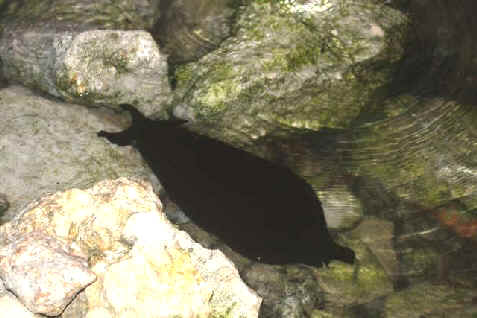
This odd creature, the ATLANTIC BLACK SEA
HARE,
was seen at night during a FONT tour
along the Caribbean coast
of the Yucatan Peninsula in Mexico, in March 2009.
Occurrences have also been recorded in coastal waters of Bermuda,
the eastern US, notably Florida, and in Trinidad and
Isla Cubagua,
off the Caribbean coast of Venezuela.
We do not know of it ever having been found by any West Indian island,
but even so, we opted to include it here in this list.
Its Spanish name, "Tinta", is because it ejects ink when
disturbed.
The word "tinta" in Spanish means "ink".
The creature, 16
inches long, and 14 inches across,
When it swims, its large parapodia is spread very widely,
Swimming is in the direction of its "two-pronged head",
in other words, toward the upper left of the photo.
(photo by Marie
Gardner)
- Ragged Sea Hare ______
(ASC:148) West Indies, and south and west Florida and Texas
Bursatella leachi
- Common Lettuce Slug ______
(ASC:212) West Indies, also south Florida
Tridachiia crispata
BIVALVES (Class Bivalvia)
- West Indian Awning Clam
______
Solemya occidentalis
- Pointed Nut Clam ______
(PS:18)
Nuculana acuta
- Carpenter's Nut Clam ______ (PS:18)
Nuculana carpenteri
- Mossy Ark ______ (PS:19)
also north of the Caribbean to North Carolina, and south to Brazil, also
Bermuda
Arca imbricata
- Turkey Wing ______
(PS:19) West Indies including Bahamas, also North Carolina to
Texas and south to Brazil
Arca zebra
- Red-brown Ark ______
(PS:19)
Barbatia cancellaria
- White-bearded Ark ______
(ASC:323) (PS:19) West Indies including Bahamas, also North
Carolina to TExas and south to Brazil
Barbatia candida
- White Miniature Ark ______
(PS:19)
Barbatia domingensis
- Doc Bales' Ark ______
(PS:19)
Barbatia tenera
- Adams' Miniature Ark
______ (PS:18) also north of the Caribbean to North Carolina,
and south to Brazil
Arcopsis adamsi
Arcopsis adamsi is found in shallow water, under stones.
- Incongruous Ark ______ (PS:19)
also north of the Caribbean to North Carolina, and south
to Brazil
Anadara brasiliana
- Chemnitz's Ark ______
(PS:19) also south of the Caribbean to Brazil
Anadara chemnitzi
- Cut-ribbed Ark ______
(PS:19)
Anadara floridana
- Eared Ark ______
(PS:19) occurs from Florida to Brazil, also Bermuda
Anadara notabilis
Anadara notabilis was said to be Arca
auriculata, but that species is in the
area of the Red Sea.
It was also said to be Arca deshayesi.
- Blood Ark ______ (ASC:329)
(PS:19) West Indies including Bahamas, also Cape Cod
MA to Florida and Texas
Anadara ovalis
- Transverse Ark ______ (PS:19)
occurs north of the Caribbean to Massachusetts
Anadara transversa
- Sulcate Limopsis ______ (PS:19)
occurs north of the Caribbean to Massachusetts
Limopsis sulcata
- American Bittersweet ______
(PS:19) occurs north of the Caribbean to Texas, and south to
Brazil
Glycymeris americana
- Decussate Bittersweet ______
(PS:19)
Glycymeris decussata
The Decussate Bittersweet was described by Linnaeus in 1758.
- Comb Bittersweet ______
(ASC:365) (PS:19) West Indies including Bahamas, also North
Carolina to Florida
Glycymeris pectinata
- Atlantic Bittersweet ______ (PS:19)
Glycymeris undata
The Atlantic Bittersweet was described by Linnaeus in 1758.
MUSSELS
- Tulip Mussel ______
(PS:20)
Modiolus americanus
- False Tulip Mussel ______
(PS:20)
Modiolus modiolus squamosus
The False Tulip Mussel is a subspecies of the Northern Horse
Mussel.
- Yellow Mussel ______
(PS:18)
Brachidontes modiolus
The Yellow Mussel was described by Linnaeus in 1767.
- Scorched Mussel ______
(PS:18)
Brachidontes exustus
The Scorched Mussel was described by Linnaeus in 1758.
- Hooked Mussel ______
(PS:18) occurs north of the Caribbean to Cape Cod
Ischadium recurvum
- Artist's Mussel ______
(PS:21)
Gregariella coralliophaga
The Artist's Mussel has also been said to be Mytilus opifex. It is a
variable species.
- Lateral Mussel ______ (PS:23)
occurs north of the Caribbean to North Carolina, and
south to Brazil
Musculus lateralis
- Cinnamon Mussel ______
(PS:20) occurs north to the Caribbean to North Carolina, also
Bermuda
Borula fusca
- Say's Chestnut Mussel ______ (PS:20)
occurs south of the Caribbean to Brazil
Lioberus castaneus
- Giant Date Mussel ______ (PS:20)
occurs south of the Caribbean to Brazil
Lithophaga antillarum
- Scissor Date Mussel ______
(PS:20) occurs north of the Caribbean to North Carolina
Lithophaga aristata
- Mahogany Date Mussel ______
(PS:20) occurs north of the Caribbean to North Carolina,
also Bermuda
Lithophaga bisulcata
- Black Date Mussel ______
(PS:20)
Lithophaga nigra
PURSE SHELLS
- Flat Tree Oyster ______ (ASC:357)
(PS:21) West Indies including Bahamas, also south
Florida to Texas and Central America
Isognomon alatus
The Flat Tree Oyster is commonly found in large compact clumps, especially
on mangrove roots.
- Lister's Tree Oyster ______
(PS:21) occurs south of the Caribbean to Brazil, also Bermuda
Isognomon radiatus
The Lister's Tree Oyster has also been said to be Isognomon listeri.
PEARL OYSTERS
- Atlantic Winged Oyster ______
(PS:21) occurs north of the Caribbean to North Carolina, and
south to Brazil, also Bermuda
Pteria colymbus
- Atlantic Pearl Oyster ______
(ASC:346) (PS:21) West Indies including Bahamas, also
Bermuda and south Florida to Texas
Pinctada imbricata
The Atlantic Pearl Oyster was said to be Pinctada radiata.
PEN SHELLS
- Amber Pen Shell ______
(PS:21) occurs north of the Caribbean in Bermuda
Pinna carnea
- Half-naked Pen Shell
______ occurs north of the Caribbean to North Carolina, and
south to Argentina
Atrina seminuda
The Half-naked Pen Shell (above) and the Stiff Pen Shell (below) occupy the
same range and can not externally be distinguished from each other, although
the Half-naked Pen Shell is usually a more tan-purple.
The differences are in the soft parts and muscle scars.
- Stiff Pen Shell ______
(ASC:298,354) (PS:21) West Indies including Bahamas,
also North Carolina to Florida
Atrina rigida
- Saw-toothed Pen Shell ______ (ASC:299)
(PS:21) West Indies, also Mexico and North Carolina to
Texas
Atrina serrata
SCALLOPS (including
the Lion's Paw, and
the Kitten's Paw)
- Ravenel's Scallop ______
(PS:22) occurs north of the Caribbean to North Carolina
Euvola raveneli
- Zigzag Scallop ______
(PS:22) occurs north of the Caribbean to North Carolina
Euvola ziczac
The Zigzag Scallop was described by Linnaeus in 1758.
- Paper Scallop ______
(PS:22) occurs south of the Caribbean to Brazil
Euvola papyracea
- Laurent's Scallop ______
Euvola laurenti
The Laurent's Scallop is a rather large West Indian species of Euvola, used
for food.
- Little Knobby Scallop ______
(PS:22) occurs north of the Caribbean in Bermuda
Caribachlamys imbricata
- Ornate Scallop ______
(PS:22) occurs south of the Caribbean to Brazil
Caribachlamys ornata
- Sentis Scallop ______ (PS:22)
occurs south of the Caribbean to Brazil
Caribachlamys sentis
- Antillean Scallop ______
(PS:23,24) occurs north of the Caribbean in Bermuda
Bractechlamys antillarum
- Kitten's Paw (ph) ______
(ASC:361) (PS:25) West Indies including Bahamas, also
North Carolina to Texas
Plicatula gibbosa
The Kitten's Paw has been
Plicatula imbricata and
Plicatula spondyloidea.
When the Kitten's Paw is washed up on the beach, its colors
quickly fade in the sunlight.
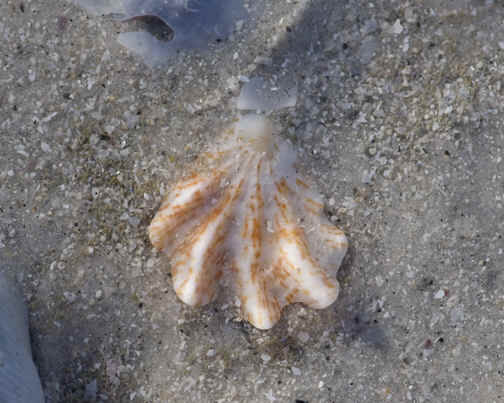
Kitten's Paw
- Lion's Paw (ph) ______
(ASC:352) (PS:22) West Indies including Bahamas, also
Cape Hatteras to Texas, and south to Brazil, also Bermuda
Nodipecten nodosus
The Lion's Paw was described by Linnaeus in
1758. It is a large, handsome scallop that is prized by shell
collectors.
The hollow bumps along the ribs are reminiscent of the knuckles on the toes
of a lion.
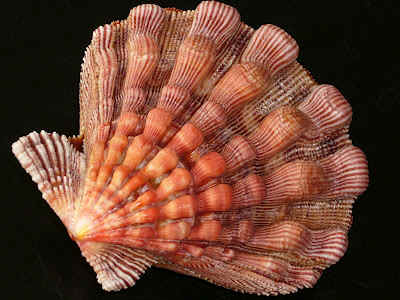
Above & below: the Lion's Paw Scallop
Below as it appears in the sea.
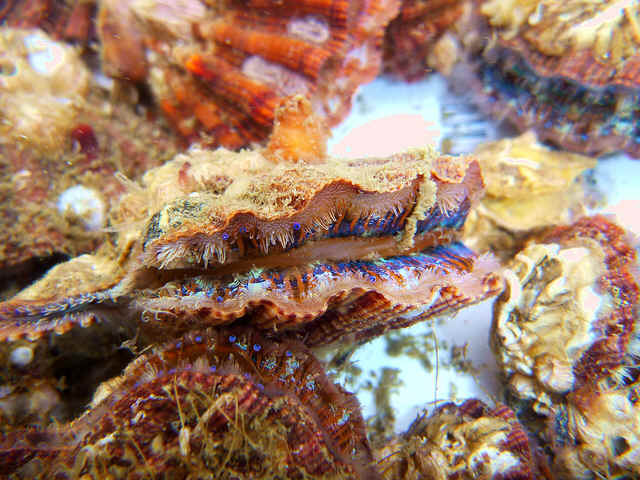
- Calico Scallop ______
(PS:22) occurs along the north coasts of Puerto Rico
and Cuba, also North Carolina to Texas
Argopecten gibbus
The Calico Scallop was described by Linnaeus in 1758. Its colors are
highly variable and mottled, combining white, red, purple, brown, orange,
and yellow.
- Nucleus Scallop ______ (PS:22)
Argopecten nucleus
- Thistle Scallop ______
(PS:23)
Aequipecten acanthodes
- Rough Scallop ______
(PS:22)
Aequipecten muscosus
- Spathate Scallop ______ (PS:24)
occurs north of the Caribbean to Cape Cod, MA
Cryptopecten phrygium
FILE SHELLS
- Spiny File Shell ______
(PS:26) occurs north of the Caribbean in Bermuda
Lima lima
The Spiny File Shell was described by Linnaeus in 1758.
- Antillean File Shell ______
(ASC:325) West Indies including Bahamas, also North
Carolina to Florida and Texas
Lima pellucida
The Antillean File Shell was formerly Lima inflata. That species is a South
American shell.
- Rough File Shell ______
(ASC:350) West Indies including Bahamas, also South
Carolina to Florida
Lima scabra scabra
- Small-eared File Shell
______ occurs north of the Caribbean to Greenland
Limatula subauriculata
OYSTERS
- Atlantic Thorny Oyster ______
(ASC:349) West Indies including Bahamas, also North Carolina to
Florida and Texas
Spondylus americanus
When specimens of the Atlantic Thorny Oyster are found washed up on the
beach, their spines have often been broken off by surf action.
- Eastern Oyster ______
(ASC:289) West Indies including Bahamas, also from Canada to
Florida and Texas, and beyond to southern South America; introduced on the North American Pacific coast
Crassostrea virginica
The common edible oyster of the eastern seaboard of North America,
the Eastern Oyster, Crassostrea virginica, has been popular as food
and heavily harvested . Its total range is in Atlantic coastal waters from
Canada to Argentina.
Crassostrea virginica has been
called the Common Atlantic Oyster.
Eastern Oysters are prolific. Each female
routinely spawns 10 to 20 million eggs. Large oysters may spawn up to
100 million.
An oyster may change its sex several times in successive seasons, but
larger ones are generally functional females. A large oyster may spawn
several times in one year.
Not all Oysters have the same shape. Pacific Oysters are oval. European
Oysters are flat and round.
American oysters, from the
Eastern Seaboard of the US and the Caribbean, Crassostrea virginica, are similar but
with a slightly more elongated shape.
With a powerful muscle that holds the shell shut, oysters filter
nutrients from the vast quantity of seawater they take in daily, and they
can be difficult to open.
Some oyster varieties, notably Pacific Oysters, are farmed
extensively. Oysters must be harvested from purified or unpolluted
water once landed, to ensure that they are safe to eat.
Oysters are available live in the shell, canned in brine, and smoked.
Live oysters should be kept chilled and lightly covered, with the
flat shell uppermost to prevent loss of the salty liquor.
There are various methods for opening oysters. If prying (or prising)
them, open with a knife. A proper oyster knife is the safest option because
a more flexible blade can snap and cause injury. If they are to be cooked,
they can be put into a very hot oven for a few moments until they open.
The whorls on the shells and, more importantly, the flavor of oysters
greatly depends on their diet. Flavors can be sweet, metallic, grassy, or
nutty.
Oysters are often served simply with a squeeze of lemon
juice.
- Coon Oyster ______ (ASC:359)
West Indies, also north to North Carolina
Dendrostrea frons
JINGLE SHELLS
- Common Jingle Shell ______
(ASC:345) West Indies including Bahamas, also Maine to Florida
and Texas
Anomia simplex
When strung on a cord and suspended in the wind, the shells of Anomia
simplex make a fine jingling sound.
LUCINES
- Buttercup Lucine ______
(ASC:333) West Indies including Bahamas, also North Carolina to
Texas
Anodontia alba
- Tiger Lucine ______
(ASC:332) West Indies including Bahamas, also south Florida and
Texas
Codakia orbicularis
(was Lucina tigrina)
Another name for Codakia orbicularis is
Great White Lucine. By whatever
name, it is abundant in the West Indies.
- Cross-hatched Lucine ______
(ASC:331) West Indies including Bahamas, and north to
Massachusetts, south to Brazil
Divaricella quadrisulcata
JEWEL BOXES
- Leafy Jewel Box ______
(ASC:347) West Indies including Bahamas, and north to North
Carolina, south to Brazil
Chama macerophylla
Shells of the Leafy Jewel Box washed ashore by storms usually have lost most
of their leafy scales in the surf.
- Florida Spiny Jewel Box ______
(ASC:348) West Indies including Bahamas, also North Carolina to
Texas
Arcinella cornuta
The Florida Spiny Jewel Box is commonly found on the beach, but with most of
its spines worn off by the surf.
CLAMS (including
COCKLES)
Many COCKLES are
somewhat heart-shaped when viewed from the end.
- Atlantic Strawberry Cockle ______
(ASC:362) West Indies including Bahamas, also North Carolina to
Florida
Americardia media
- Common Egg Cockle ______ (ASC:330)
West Indies, also Mexico, and North Carolina to Texas
Laevicardium laevigatum
- Morton's Egg Cockle ______
(ASC:342) West Indies, also Mexico, and Cape Cod MA to Florida
and Texas
Laevicardium mortoni
- Yellow Cockle ______ (ASC:363)
West Indies, and from North Carolina to Texas, and south to Brazil
Trachycardium muricatum
- Disk Dosinia (or Disk
Shell) ______
(ASC:334) in
the Bahamas, also Mexico, and from Virginia to Florida and Texas
Dosinia discus
- Southern Quahog ______
(ASC:336) in Cuba, also Mexico, and from Virginia to Texas
Mercenaria campechiensis
TELLIN
- Candy Stick Tellin ______
West Indies, and south Florida
Tellina similis
The Candy Stick Tellin is
1 inch long and five-eighths of an inch high. It is glossy white with
radiating pink rays.
ROCK BORER
- Red Nose ______
(ASC:306) (PAS:27) (PS:36) ranges from the Arctic to the West
Indies
Hiatella arctica
Another name for Hiatella arctica is
Arctic Rock Borer.
PIDDOCKS
- Angel Wing (ph) ______
(ASC:296) (PAS:27) (PS:38) West Indies, also Mexico, and Cape Cod MA to
Texas, and south to Brazil
Cyrtopleura costata
Described by Linnaeus in 1758, the Angel Wing belongs to a family
of borers, the PHOLADS.
When cleaned, the two delicate and graceful valves held together by the
hinge ligament truly suggest the wings of an angel.
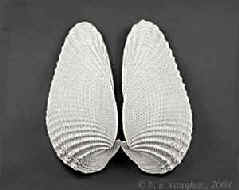
Angel Wing
- Striated Wood Piddock ______
(ASC:313) West Indies, also North Carolina to Texas,
south to Brazil
Martesia striata
SHIPWORM
- Common Shipworm ______
(ASC:311) (PAS:27) West Indies, also Newfoundland,
Canada to Texas
Teredo navalis
The Common Shipworm was described by
Linnaeus in 1758.
SQUIDS
and OCTOPUSES, the CEPHALOPODS
(Class Cephalopoda)
Octopuses (and
their close cousins the Squids) can change their color almost
instantly.
That is due to color cells on their skin called chromatophores. Those
cells are sacs of colored pigment that expand or contract to create just
about any color or pattern found on a coral
reef.
SQUIDS
- Atlantic Long-fin Squid ______
(ASC:486)
Loligo pealei
- Plee's Striped Squid ______
(PCR:31)
Loligo pleii
- Brief Thumbstall Squid ______
Lolliguncula brevis
- Pickford's Squid ______
Pickfordiateuthis pulchella
- Atlantic Oval Squid (or Reef
Squid) (ph) ______ (PCR:31)
Sepioteuthis sepiodea
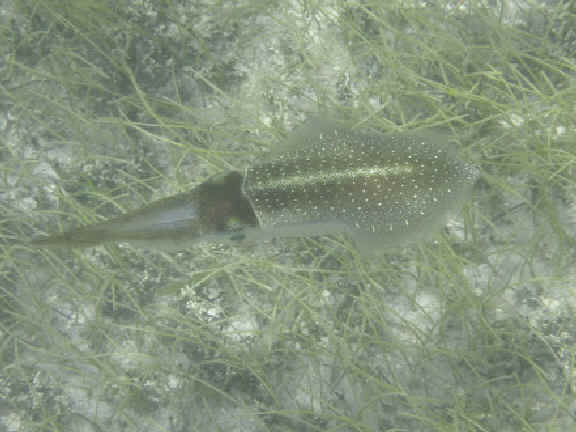
The Atlantic Oval Squid, or Reef Squid, in the
Caribbean
(photo courtesy of Dian Allison)
- Common Spirula ______
Spirula spirula
OCTOPUSES
- Common Atlantic Octopus
______ (ASC:480)
Octopus vulgaris
Octopus vulgaris
is the largest of the shallow-water octopods, with a
maximum radial spread of about 7 feet. It grows to 3 feet, including the
longest arm.
- Caribbean Reef Octopus ______
Octopus briareus
Another name for Octopus briareus is
Briar Octopus. It grows to 1 and a half
feet. Its longest arm is about 5 times the body length. The arms are thick
at their bases.
- Four-eyed Reef
Octopus ______ (PCR:31)
Octopus hummelincki
Another name for Octopus hummelincki is
Seaweed Octopus. It is small,
growing to 8 inches.
- Long-armed Octopus (ph) ______ (ASC:482)
Octopus macropus
Other names for Octopus macropus are
White-spotted Octopus and Grass
Octopus. It grows up to 3 and a quarter feet, including the longest arm.
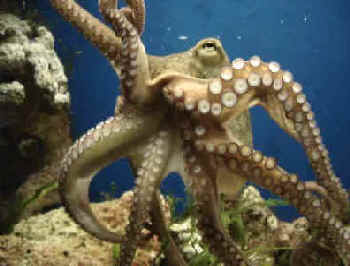
Long-armed Octopus, or White-spotted Octopus
- Joubin's Octopus ______ (ASC:481)
Octopus joubini
Another name for Octopus joubini is Atlantic Pygmy Octopus. As the name
implies, it is small, growing only up to 6 inches.
Although Octopus joubini is the smallest American
octopod, it lays the largest eggs.
ARTHROPODS
CRUSTACEANS
- Little Gray Barnacle ______ (ASC:276)
(PAS:18) from the Caribbean north to the Delaware Bay
and Cape Cod
Chthamalus fragilis
- Little Striped Barnacle ______
(ASC:279) from the Caribbean north to Cape Cod
Balanus amphitrite
- Ivory Barnacle ______
(ASC:275) (PAS:18) from the Caribbean north to Maine,
south to South America
Balanus eburneus
- Bay Barnacle ______ (ASC:274)
from the Caribbean north to to Cape Cod
Balanus improvisus
- Crab Barnacle ______ (PAS:18)
practically worldwide in warm seas, common north to North Carolina
Chelonibia patula
- West Indian Volcano Barnacle
______
Tetraclita
stalactifera
ISOPODS
- Southern Gribbles ______ from
the Caribbean north to Rhode Island
Limnoria
tripunctata
- Sea Roach ______
(PAS:50) from the Caribbean north to the Chesapeake
Bay
Ligia exotica
SHRIMPS
and LOBSTERS
- Common Rock Mantis Shrimp ______ (ASC:595)
Gonodactylus oerstedii
Another name for Gonodactylus oerstedii is
Swollen-clawed Squilla. Among other places, it occurs in the Bahamas.
If one has the misfortune of touching a mantis shrimp, that is hidden
in a crevice in coral, it may lash out with its razor-sharp finger,
splitting his or hers. Thus, the name for these shrimps: thumb busters.
- Ciliated False Squilla ______ (ASC:592,597)
Pseudosquilla ciliata
- Scaly-tailed Mantis Shrimp ______
(ASC:596)
Lysiosquilla scabricauda
- Common Watchman
Shrimp ______
Pontonia mexicana
- Snapping Shrimps (or Pistol
Shrimps) ______ (PCR:29)
Alpheus spp.
Brown Pistol Shrimp ______ (ASC:622)
Alpheus armatus
- Sponge Shrimps
______ (PCR:29)
Synalpheus spp.
- Long-clawed Sponge
Shrimp ______ occurs from North Carolina and the Florida
Keys to Trinidad
Synalpheus longicarpus
- Synalpheus minus
______
Synalpheus minus is one-half
inch long. It occurs in green sponges.
- Short-clawed Sponge
Shrimp ______
Synalpheus brevicarpus
The following PENAEID SHRIMPS
are often abundant where they occur.
- White Shrimp
______ (PAS:55,56)
from the Caribbean north to Long Island, NY
Penaeus setiferus
The White Shrimp is the largest of the penaeids.
- Brazilian Shrimp
______
Penaeus brasiliensis
- American Pink Shrimp ______
(ASC:609,611) (PAS:55,56) from the Caribbean north to
the Chesapeake Bay
Penaeus duorarum
- Brown Shrimp
______ (PAS:55,56) from
the Caribbean north to Cape Cod
Penaeus aztecus
- Lucifer Shrimp ______
(PAS:53) a warm water oceanic plankter
Lucifer faxoni
- Acetes americanus
______ from the Caribbean
north to the Chesapeake Bay, south to Brazil
- Arrow Shrimp ______
(PAS:55) from the Caribbean north to Cape Hatteras,
rarely north to Cape Cod
Tozeuma
carolinense
- Gulfweed Shrimp ______
(PAS:55) in warmer Atlantic waters, but drifts widely
Latreutes
fucorum
Other Gulfweed Shrimps:
-
Leander tenuicornis ______
- Hippolyte coerulescens
______
All 3 of the Gulfweed Shrimps
noted above occur in the Bahamas, where, by far,
Latreutes focorum is the most common.
- Grass Shrimp _____
(PAS:55) from the Caribbean north to Cape Cod
Hippolyte
zostericola
- Pederson's Cleaning Shrimp ______
(ASC:616)
Periclimenes pedersoni
- Spotted Cleaning Shrimp ______ (ASC:617)
Periclimenes yucatanenicus
- Banded Coral Shrimp ______
(ASC:618) (PCR:29)
Stenopus hispidus
Another name for Stenopus hispidus is Barber Pole Shrimp.
- Grabham's Cleaning Shrimp ______
(ASC:615)
Lysmata grabhami
- Red-lined Cleaning Shrimp ______
(ASC:613) (PCR:29) from the Caribbean
north to the Chesapeake Bay, south to Brazil
Lysmata wurdemanni (or Hippolysmata
wurdemanni)
Other names for Lysmata wurdemanni are
Peppermint Shrimp and Veined Shrimp.
- Caribbean Lobster (or
Caribbean Lobsterette) ______
Metanephrops binghami
- West Indian Spiny Lobster (*) ______ (ASC:625)
(PCR:29)
Panulirus argus
The West Indian Spiny Lobster grows
up to 21 inches in length. Its range is from North Carolina to Brazil, but
it is sadly depleted in some tourist regions.
- Ridged Slipper Lobster ______
(PCR:29)
Scyllarides nodifer
Scyllarides nodifer
is lobster-like in appearance, but greatly flattened. It is
one-foot long, sandy-colored, and mottled with purple-brown coloration.
It is most likely to be seen at night on the surface of reefs or in the
inshore surf zone.
The Ridged Slipper Lobster occurs throughout the Caribbean, but it is
not really common anywhere.
- Spanish Lobster ______ (ASC:626,627)
Scyllarides aequinoctialis
- Flat-browed Mud Shrimp ______ (ASC:621)
(PAS:57) from the Caribbean north to Cape Cod, south
to Brazil
Upogebia affinis
CRABS
PORECELAIN CRABS, HERMIT
CRABS, and ANOMURAN or MOLE CRABS
- Say's Porcelain Crab (ph) ______
HS
(ASC:647) North Carolina to Brazil
Porcellaria sayana
Another name for Porcellaria sayana is Spotted Porcelain Crab.
It is small, only about an inch wide. It is often found in association
with the Queen Conch, and with marine hermit crabs occupying vacant
shells.
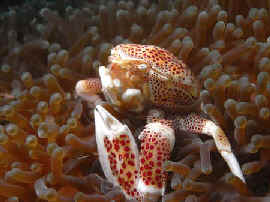
Above & below: Say's Porcelain Crab,
or Spotted Porcelain Crab
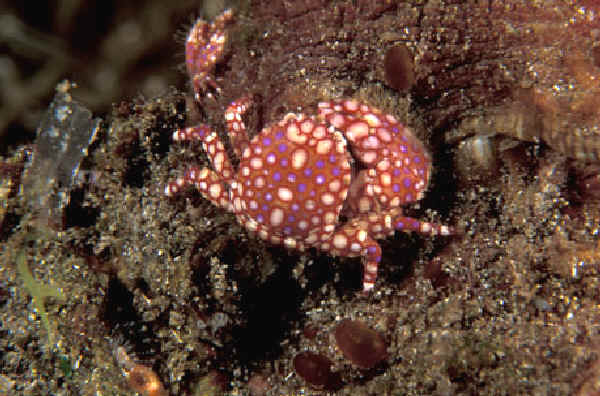
- Rough-clawed Porcelain Crab
______ from the Gulf of Mexico to Brazil
Pachycheles ackleianus
- Flat-clawed Hermit Crab
______ (PAS:57) in shallow water in the Caribbean from Florida south to
Barbados
Pagurus operculatus
- Gray's Hermit Crab ______
throughout the Caribbean
Paguristes grayi
- Land Hermit Crab (ph) ______
HS
(ASC:685)
Coennobita clypeatus
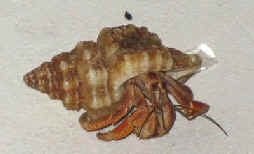
Land Hermit Crab
(photo courtesy of Michiel Koomen)
- Giant Hermit Crab ______
HS
(ASC:682) North Carolina to Brazil
Petrochirus diogenes
Another name for Petrochirus diogenes is Red Hermit Crab.
Petrochirus diogenes is frequently in the Queen Conch Shell.
- Striped Hermit Crab ______ HS
(ASC:684)
(PAS:57)
Clibanarius vittaus
- Star-eyed Hermit Crab ______ HS
(ASC:687) (PCR:30) throughout the Caribbean, and south to Brazil
Dardanus venosus
- Bar-eyed Hermit Crab ______ HS
(ASC:680)
Dardanus focosus
The Bar-eyed Hermit Crab occurs with the Star-eyed Hermit Crab
(above).
- Smooth-clawed Hermit
Crab ______
Calcinus tibicen
- Parchment Worm Polyonyx
______ (PAS:60) in the Caribbean; north of the Caribbean
to Cape Cod
Polyonyx gibbesi
Polyonyx gibbesi is a small, grayish-white crab, with "oversized
claws". It is hardly ever found outside the burrows of the
Parchment Worm.
TRUE CRABS, SHORT-TAILED or TAIL-LESS CRABS
- Round Sponge Crab ______ HS
(ASC:670)
Dromia erythropus
- Lesser Sponge Crab
______ HS (ASC:669)
Dromidia antillensis
- Purse Crab ______
Persephona punctata
About 6 species of SHAMEFACED CRABS or BOX CRABS occur in the Caribbean,
including the two CALAPPA species below.
- Flame-streaked Box Crab ______ (ASC:671)
Calappa flammea
Other names for Calappa flammea are Flaming Shamefaced Crab or Flaming Box
Crab. It occurs north of the Caribbean to Massachusetts, and south to
Brazil, and also in Bermuda.
In the Caribbean, in addition to being so other places, it is common in the
Bahamas.
- Yellow Box Crab ______ HS
(ASC:673)
Calappa gallus
The following species, in the genus HEPATUS, is
in the Family AETHRIDAE. It has been in CALAPPIDAE.
- Calico Crab (ph) ______ HS
(PAS:58)
north of Caribbean to the Chesapeake Bay, in teh Caribbean south to
Hispaniola and Jamaica
Hepatus epheliticus
The Calico Crab was described by Linnaeus in 1763. It is also called the
Dolly Varden Crab.
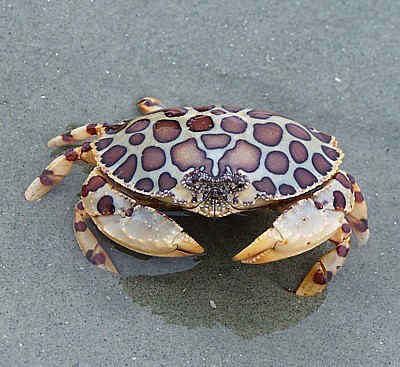
Calico Crab
Species in the following PORTUNUS genus are known either as PORTUNUS CRABS
or SWIMMING CRABS.
- Spotted Swimming Crab ______
(PCR:30)
Portunus sebae
Another name for Portunus sebae is
Spotted Portunus.
- Sargassum Crab (ph) ______
(ASC:658)
Portunus sayi
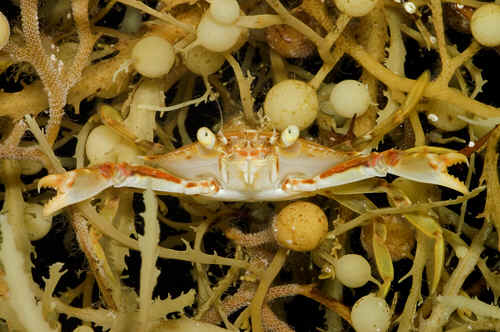
Sargassum Crab
- Spiny-banded Crab ______ HS
Portunus spinimanus
- Flat-browed Crab ______ HS
(ASC:633)
Portunus depressifrons
Species in the genus that follows,
CALLINECTES, are also in the Family PORTUNIDAE.
- Common Blue Crab (ph) ______
HS (ASC:657)
(PAS:61)
Callinectes sapidus
Callincetes sapidus
is a common species along the eastern seaboard of the US
and throughout the West Indies.
It has only 2 teeth between its eyes. Other Callinectes species have 4.
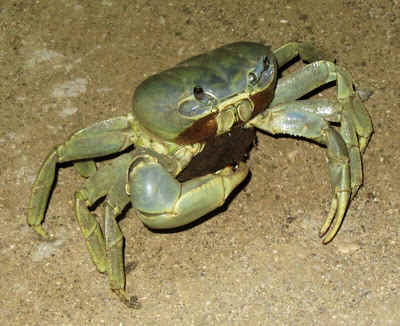
A Common Blue Crab photographed in Curacao
(photo courtesy of Michiel Koomen)
- Ornate Blue Crab
______
Callinectes ornata
Callinectes ornata is similar to Callinectes sapidus
(above), but its
carapace is more greenish, covered with brown hairs. Its walking legs are
blue with coral tips.
- Dana's Blue Crab
______
Callinectes danae
Callinectes danae has a blue-gray carapace embellished with a scroll work of
white lines.
The following species in the genus
CARPILIUS is in the family CARPILIIDAE.
- Batwing Coral Crab (ph) ______
HS
(ASC:648) Bahamas to Brazil
Carpilius corallinus
Carpilius corallinus
has also been known as simply the Coral Crab.
The Batwing Coral Crab was once common throughout its range in shallow reefs
and Turtle Grass beds, but trapping and divers have taken their toll. It is
now becoming scarce, and larger specimens are now rare.
The Batwing Coral Crab is the largest of the crabs in the Caribbean area,
with a carapace to 5 inches in length.
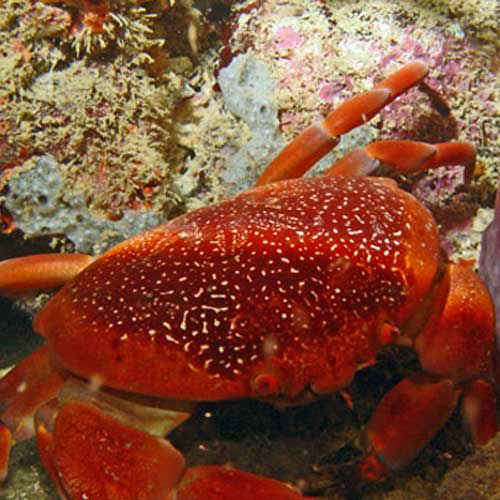
Batwing Coral Crab
The following commensal species in the
genus DOMECIA is in the family DOMECIIDAE.
- Elkhorn Coral Crab
______
Domecia acanthophora
Another name for Domecia acanthophora is
Gall Crab.
The following species
in the genera ZAOPS and TUMIDOTHERES, and others that either have been or are in PINNOTHERES,
are in the Family PINNOTHERIDAE.
- various commensal
crabs ______ (ASC:634)
Pinnotheres spp.
Many species that were formerly in PINNOTHERES have been placed in new
genera, such as the Oyster Crab and the Mussel Crab
(both below).
- Oyster Crab
______ north of the Caribbean to Massachusetts, south to Brazil;
throughout the Caribbean
Zaops ostreus (formerly Pinnotheres ostreus)
The Oyster Crab is a small, whitish or translucent crab. It is found in
mostly oysters or less so clams, living inside their gills. It uses the host
bivalve for protection and lives on the food that the oyster, or clam, gets
for itself.
The Oyster Crab is an edible sea food delicacy.
- Mussel Crab
______ north of the Caribbean to Massachusetts, south to Argentina
(the San Marias Gulf)
Tumidotheres maculatus (formerly Pinnotheres maculatus)
The following species in the genus ERIPHIA is in the Family ERIPHIIDAE.
- Warty Crab ______ HS
Eriphia gonagra
The following species in the genus
EURYPANOPEUS is in the Family PANOPEIDAE.
- Flat Mud Crab ______ HS
(ASC:645)
Eurypanopeus depressus
- Black-fingered Mud
Crab ______ (PAS:59) north of the Caribbean to
Massachusetts, south to Santa Catarina, Brazil
Panopeus herbstii
Another name for Panopeus herbsttill is Black-clawed Mud Crab.
STONE CRABS
- Stone Crab (ph) ______ HS
(ASC:642) from North Carolina to the Yucatan,
including the Bahamas and Greater Antilles
Menippe mercenaria
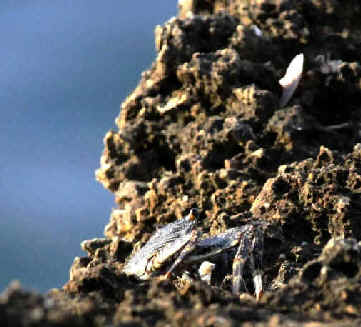
A Stone Crab blending in on a rock by the sea at Boca de Yuma
during the April 2012 FONT Dominican Republic Tour.
(photo by Marie Gardner)
- Menippe nodifrons
______ Florida to Brazil, throughout the West Indies
Menippe nodifrons is smaller than Menippe mercenaria
(above). The carapace
of Menippe nodifrons is to 1 and seven/eighths inches long. That of
Menippe
mercenaria is to 3 and one-half inches.
The following species in the genera GRAPSUS,
PERCNON, PLANES, and PACHYGRAPSUS are in the Family GRAPSIDAE.
Crabs in that family are called ROCK RUNNERS, SPRAY CRABS, and MARSH CRABS.
Planes minutus
(below)
is a pelagic species.
- Red Rock Crab (ph) ______
HS
(ASC:649) in the Caribbean area, and along the
Atlantic coast of South America
Grapsus grapsus
The Red Rock Crab, Grapsus grapsus,
along with the Urchin Crab, Percnon
gibbeis (below) are called "Sally Lightfoot
Crabs".
The Red Rock Crab was described by Linnaeus in 1758. In
addition to the range noted above, it is found along the Pacific coast of
Central America and South America, and in the Galapagos Islands.
The adult Grapsus grapsus is quite variable in color. Some can be muted
brownish-red, while others can be mottled or spotted brown, pink, or yellow.
Young Grapsus grapsus are black or dark brown. They are camouflaged well on
the black lava coasts of volcanic islands.
Grapsus grapsus has 5 pairs of legs. The front two have small, blocky,
symmetrical chelae. The other legs are broad and flat.
The crab's round, flat carapace is just over 3 inches in
length.
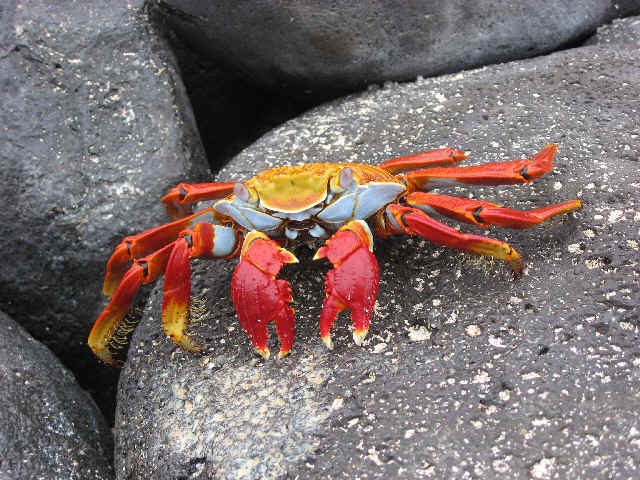
Red Rock Crab, or a "Sally Lightfoot"
- Urchin Crab ______
Percnon gibbesi
The Urchin Crab is found
near coral, usually near the Long-spined Sea Urchin. It can also be
on rocks in the spray zone.
- Gulfweed Crab ______
(PS:58) in the North Atlantic Ocean between 11 degrees and
32 degrees north latitude
Planes minutus (meaning "little
wanderer")
The Gulfweed Crab is found in Sargassum weed, floating timbers, and
in the hulls of ships. It is often found in association with sea turtles,
especially the Loggerhead Sea Turtle.
Planes minutus was described by
Linnaeus in 1758, It is believed to have been seen by Columbus in the
Sargasso Sea in 1492 (on September 17, that year). Thus, the crabs in the Planes
genus (with at least 2 other species in other warm oceans) are sometimes
called "Columbus Crabs".
- Mottled Shore Crab ______ HS
Pachygrapsus
transversus
The following species
in the genus PLAGUSIA is in the Family PLAGUSIIDAE.
- Flattened Crab ______ HS
Plagusia depressa
The following species in the genus CARDISOMA is
in the Family GECARCONIDAE.
- Giant Blue Land Crab (ph) ______
HS (ASC:632)
Cardisoma guanhumi
Another name for Cardisoma
guanhumi is Great Land Crab. In the Caribbean, it
occurs in the Bahamas and on Hispaniola and Puerto Rico.
It is also in Florida, Central America, and to the south in Colombia and
Venezuela.
In the Bahamas and Central America, Cardisoma
guanhumi is exploited for food. In the US and Puerto Rico, it
is considered a pest.
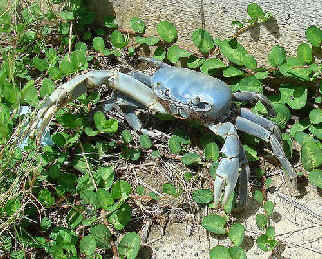
Giant Blue Land Crab
The following species in the genus GECARCINUS are
in the Family GECARCINIDAE.
- Mountain Crab ______ HS (ASC:638)
from western Cuba through the Antilles to Barbados
Gecarcinus ruricola
Other names for Gecarcinus ruricola
are Purple Land Crab, Red Land Crab, and Zombie Crab. By
whatever name, it is a terrestrial crab, the most terrestrial of the
Caribbean land crabs.
Four color morphs exist: black, red, yellow, and green.
In the addition to range given above, Gecarcinus
ruricola occurs in Curacao, the Swan Islands off Honduras,
San Andres and other islands off the Colombian coast, and in Belize at Half
Moon Caye.
The Mountain Crab is highly prized as food in the West Indies.
- Blackback Land Crab ______ DM on various islands in the Caribbean; to the north in
Florida and Texas, to the south in Venezuela
Gecarcinus lateralis
The Blackback Land Crab occurs in the dry zone of sandy beaches and in
nearby hills. It needs to return to the ocean to breed. The larvae are
released into the sea.
The following species in the genus OCYPODE
is in the Family OCIPODIDAE.
- Atlantic Ghost Crab (ph) ______
HS (ASC:631) (PAS:58) north of the
Caribbean to Massachusetts, south to Rio Grande do Sul in southern Brazil
Ocypode quadrata
The Atlantic Ghost Crab is more active at night than it is in the daytime. It is an
inhabitant of sandy beaches.
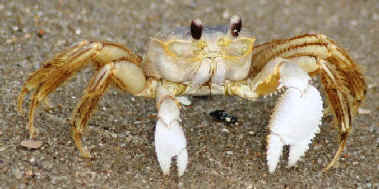
Atlantic Ghost Crab
FIDDLER CRABS
- Sand Fiddler ______ HS
(ASC:628) (PAS:58)
Uca pugilator
- Brackish-water Fiddler ______ HS
(ASC:629)
(PAS:58)
Uca minax
SPIDER CRABS
- Doubtful Spider Crab ______ occurs
in
the Bahamas and Cuba, and north of the Caribbean to Cape Cod
Libinia dubia
- Green Reef Crab
______
Mithrax sculptus
Another name for Mithrax sculptus is Emerald Mithrax Crab. It occurs in
scattered places from Florida and the Bahamas south throughout the West
Indies, and beyond to Brazil, on reefs. gravel, and in Turtle Grass beds
where it is especially abundant on shallow finger coral flats and reefs.
There are about 20 Milthrax species in the Caribbean, some very large.
Spooned claws with a blunt tooth are characteristic.
- Mithrax coryphe
______
Mithrax coryphe is similar to Mithrax sculptus
(above), but it is pale
sand-colored.
- Spiny Spider Crab ______ HS
(ASC:640)
Mithrax spinosissimus
- Sponge Spider Crab
______ from North Carolina to Brazil
Macrocoeloma trispinosum
- Atlantic Decorator Crab ______ HS
Stenocianops furcata
Another name for Stenocianops furcata is
Giant Decorator Crab. Its carapace
is up to 6 inches in length.
Stenocianops furcata is often covered with encrusting organisms.
- Arrow Crab ______ HS
(ASC:574)
(PCR:20,30) from North Carolina to Brazil, also Bermuda
Stenorhynchus seticornis
- Red-spotted Spider
Crab ______ (PAS:60) in the West Indies, further
north to Cape Cod
Pelia mutica
The following genera
HETEROCRYPTA and PARTHENOPE are in the Family PARTHENOPIDAE,
- Chip Crab
______ (PAS:60) north of the Caribbean to Nantucket Sound,
south to Bahia, Brazil
Heterocrypta granulata
- Pourtales' Long-armed Crab ______
HS
Parthenope pourtalesii
- Saw-toothed Crab ______
Parthenope serrata
ASTEROIDS Class Stelleroides: including the sea stars and brittle
stars
"Sea Star"
is preferred to "Star
Fish" as that term is a misnomer as "fish" are
finny vertebrates
- Common Blunt-armed Sea Star ______
Asterina folium
The Common Blunt-armed Sea Star is olive or bluish-green. Juveniles are
white.
Although common, it is difficult to find unless searched for diligently.
- Hartmeyer's Blunt-armed Sea Star
______
Asterina hartmeyeri
- Beaded Sea Star ______ (PCR:37)
Astropecten articulatus
- Spiny Beaded Sea Star ______
(PCR:37)
Astropecten duplicatus
- Limp Sea Star ______ (ASC:564)
(PCR:33)
Luidia alternata
Other names for Luidia alternata are
Weak Sea Star, or Banded Luidia.
Luidia alternata sags when lifted. Its rays are easily twisted, giving it a
rag-doll flaccidity.
It lies buried in the sand with the outline of its body or 1 ray
visible.
It occurs Turtle Grass beds and lagoons.
Luidia alternata is usually a blotchy dark brown, with tan areas or with
indistinct black or purple bands. Its underside is tan.
- Netted Sea Star
______ (PCR:33)
Luidia clathrata
Luidia clathrata
is usually buried under sandy sediment in lagoons and in
deep water, from beneath 6 and half feet to 300 feet or deeper.
- Nine-armed Sea
Star ______ (PCR:33)
Luidia senegalensis
- Cushion Sea Star (ph) ______ (ASC:541)
(PCR:33)
Oreaster reticulatus
Another name for Oreaster reticulatus is
Reticulated Sea Star. It walks over
sand bottoms of Turtle Grass beds, especially around 6 feet in depth.
It occurs throughout the Caribbean, but it has been overcollected by
souvenir hunters, so it may be locally rare.
Adults of Oreaster reticulatus are variable in color, usually tan or rust,
with dark brown or red tubercles. Juveniles are a light green.
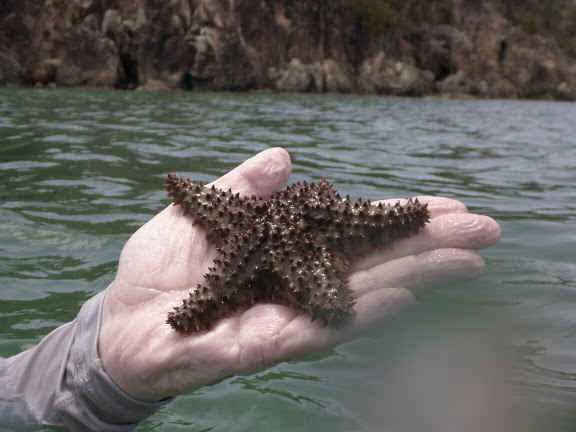
Cushion Sea Star, or Reticulated Sea Star
(photo courtesy of Diane Allison)
- Thorny Sea Star ______ (ASC:549)
(PCR:32)
Echinaster sentus
Another name for Echinaster sentus is
Red Spiny Sea Star.
- Brown Spiny Sea
Star ______ (PCR:33)
Echinaster spinulosus
The Brown Spiny Sea Star seeks light, rather than being repelled by it, and
therefore it is found in the open.
- Common Comet Sea Star ______
(PCR:33)
Linchia guildingii
The following species are the BRITTLE
STARS, also known as SERPENT STARS. One of the species that
follows is called a BASKET STAR.
Worldwide, there are over 1,800 species of BRITTLE STARS. Throughout
the islands of the Caribbean, and in southern Florida, 21 species are
common.
BRITTLE STARS seem to be "everywhere" on the coral reef,
and in its environs. There does not seem to be a hole that they do not use
for a home.
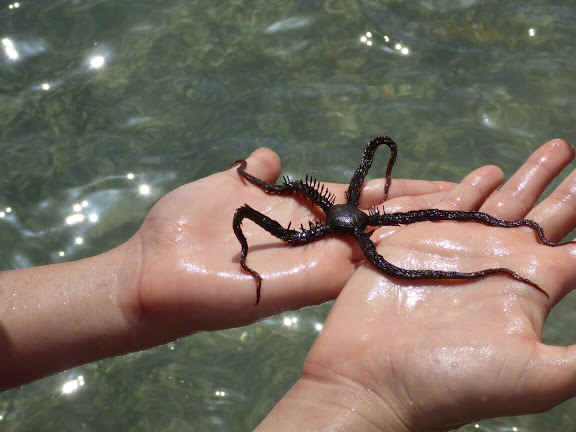
A Brittle Star in the Caribbean
(photo courtesy of Diane Allison)
- Caribbean Basket Star ______
(ASC:573)
Astrophyton muricatum
- Short-spinned Brittle Star ______
Ophioderma brevispina
- Atlantic Long-spinned Brittle Star
______
Ophiothrix angulata
The Atlantic Long-spinned Brittle Star is highly variable in
color and pattern.
- Reticulate Brittle Star ______
Ophiothrix reticulata
- Spiny Brittle Star ______
(ASC:569)
Ophiocoma echinata
SEA
URCHINS, SEA
BISCUITS, and SAND DOLLARS (Class Echinoidea)
- Long-spined Sea Urchin (ph) (*)
______ (ASC:524) (PCR:6,17)
Diadema antillarum
The Long-spined Sea Urchin has spines up to 15 inches long. The
spines contain toxin, and cause a bee-like sting.
Diadema antillarum hides in coral
crevices, aggregating in groups in a lagoon, during daytime. Groups scatter
and feed on algae and Turtle Grass at night.
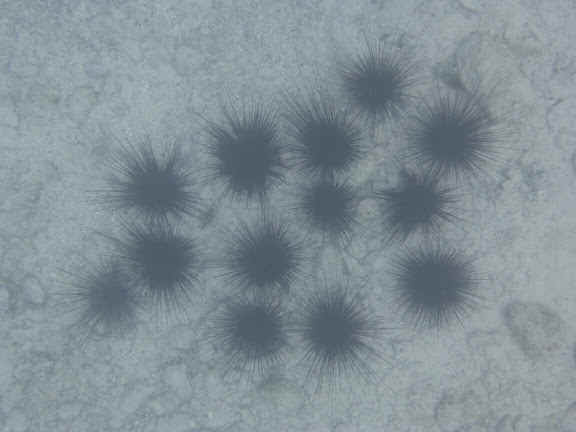
Above & below: Long-spined Sea Urchins photographed in the
Caribbean
(photos courtesy of Diane Allison)
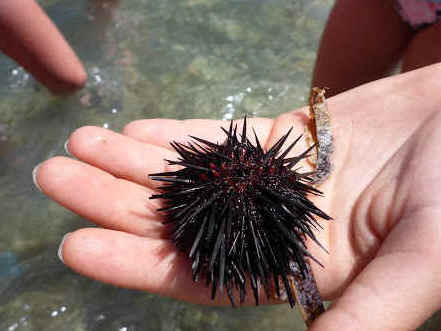
Below: a sea urchin in sand particles on a beach in Curacao
(photo courtesy of Michiel Koomen)
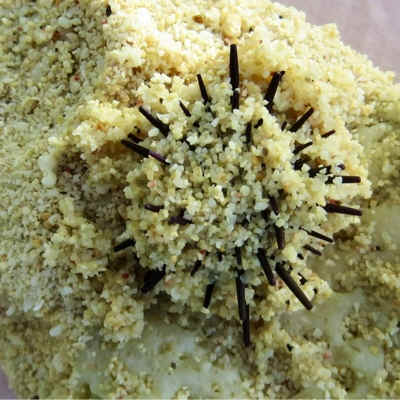
- Atlantic Purple Sea Urchin
______ (ASC:518)
Arbacia punctulata
Another name for Arbacia punctulata is
Brown Rock Urchin.
In the Caribbean, Arbacia punctulata is not found on most islands. It is
found on Trinidad, Tobago, and islands near Central America, as well as in
Cuba, Florida, and the Yucatan peninsula.
- Grooved Burrowing Urchin ______
Brissus unicolor
- Variegated Urchin ______
(ASC:521,528) (PCR:32)
Lytecinus variegatus
Other names for Lytecinus variegatus are
Variable Sea Urchin and Green Sea
Urchin.
- Williams' Variegated
Urchin ______ (PCR:34)
Lytecinus williamsi
- Hairy Pincushion Urchin (ph) (*) ______
(ASC:525) (PCR:35)
Tripneustes ventricosus
Other names for Tripneustes ventricosus
are Sea Egg and Priest-hat Urchin.
Tripneustes ventricosus
can be covered profusely with white spines, one and half inches
long.
Its hard, outer calcareous covering, to which the spines are attached, is
often covered with debris.
Tripneustes ventricosus occurs
commonly on Turtle Grass beds. Its eggs are eaten by people in the West
Indies.
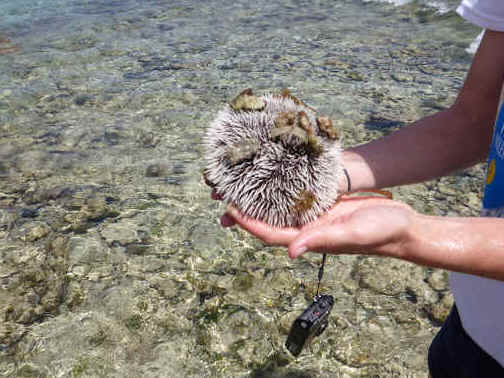
Hairy Pincushion Urchin
(photo courtesy of Diane Allison)
- Rock-boring Urchin ______
(ASC:519) (PCR:32,34)
Echinometra lucunter
Another name for Echinometra lucunter is
Red Rock Urchin.
- Reef Urchin
______ (PCR:32,34)
Echinometra viridis
- Little Burrowing
Urchin ______
Echinoneus cyclostomus
- Club Urchin (or
Pencil Urchin) ______ (PCR:34)
Eucidaris tribuloides
- Brown Sea Biscuit ______ (PCR:35)
Clypeaster rosaceus
Another name for Clypeaster rosaceus is Inflated Sea Biscuit.
- Flat Sea Biscuit
______ (PCR:35)
Clypeaster subdepressus
- Five-holed Keyhole Urchin ______ (ASC:534)
(PCR:34)
Mellita quinquiesperforata
- Six-holed Keystone Urchin ______
(ASC:532) (PCR:34)
Mellita sexiesperforata (was Leodia
sexiesperforata)
- Cake Urchin
______ (ASC:529) (PCR:35)
Meoma ventricosa
Another name for Meoma venticosa is
West Indian Sea Biscuit.
- Mud Heart Urchin ______
(PCR:34)
Moira atropos
- Long-spinned Sea Biscuit ______
(ASC:526) (PCR:35)
Plagiobrissus grandis
Another name for Plagiobrissus grandis is
Great Red-footed Urchin.
- Notched Sand
Dollar ______ buries in sand off South America and nearby
islands
Encope emarginata
SEA CUCUMBERS (Class Holothuroidea)
- Worm Cucumber
______
Chiridota rotifera
- Beaded Sea
Cucumber ______ (PCR:37)
Euapta lappa
- Seaweed Cucumber
______
Synaptula hydriformis
- Five-toothed Sea
Cucumber ______ (PCR:36)
Actinopyga agassisii
The Five-toothed Sea Cucumber is found in Turtle Grass beds in shallow water
with Three-rowed Sea Cucumbers and Donkey Dung Sea Cucumbers
(both below), in Jamaica,
Haiti, and the Bahamas.
It is rare or absent in the Virgin Islands and much of the Lesser
Antilles.
- Furry Sea Cucumber
______ (PCR:36)
Astichopus multifidus
- Donkey Dung Sea
Cucumber (ph) ______ (PCR:36,37)
Holothuria mexicana
Holothuria mexicana
is the most common sea cucumber in the Caribbean area.
It occurs in places as scattered as the Turks & Caicos Islands, Grand
Cayman Island, Cozumel Island, Bimini in the Bahamas, Bonaire, and St. John
in the Virgin Islands.
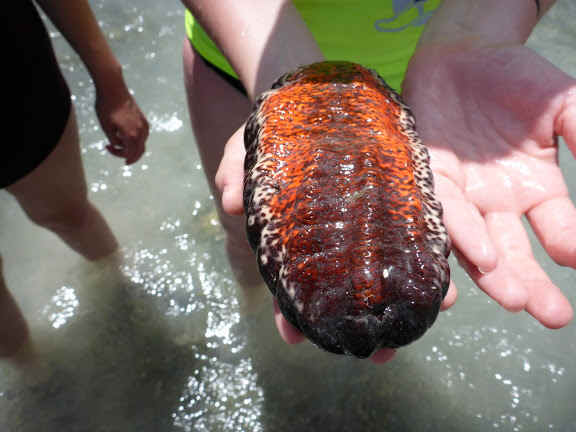
Donkey Dung Sea Cucumber
(photo courtesy of Diane Allison)
- Florida Sea
Cucumber ______
Holothuria floridana
The Florida Sea Cucumber can be almost identical with the Donkey Dung Sea
Cucumber (above).
It occurs in the western Caribbean, Jamaica, and the Dutch Antilles.
- Burrowing Sea
Cucumber ______ (PCR:36)
Holothuria arenicola
- Brown Rock Sea
Cucumber ______ (PCR:36)
Holothuria glaberrima
The Brown Rock Sea Cucumber occurs on and under rocks in the surf zone.
- Gray Sea Cucumber
______
Holothuria grisea
- Impatient Sea
Cucumber ______
Holothuria impatiens
The Impatient Sea Cucumber is said to have its name due to its readiness to
eject copious amounts of sticky white Cuvier's tubicles when it is picked
up.
- Golden Sea
Cucumber ______ (PCR:36)
Holothuria parvula
When picked up and squeezed, the Golden Sea Cucumber ejects harmless sticky
white Cuvier's tubicles.
- Surinam Sea
Cucumber ______
Holothuria surinamensis
In the Caribbean, the Surinam Sea Cucumber commonly occurs in Jamaica and
Antigua.
- Thomas' Giant Sea
Cucumber ______
Holothuria thomasae
The fully grown Thomas' Giant Sea Cucumber can be huge, with a minimum
length of over 3 feet.
It is nocturnal, hiding in the daytime.
Although it is the largest sea cucumber known in the Western Atlantic, it is
so well camouflaged that it was not described to science until 1980.
Another name for Holothuria thomasae is Tiger's Tail.
- Three-rowed Sea
Cucumber ______ (PCR:36)
Isostichopus badionotus
- Pygmy Sea Cucumber
______ (PCR:37)
Pentacta pygmaea
As its name implies, the Pygmy Sea Cucumber is small, up to 4 inches long,
but usually 2 inches.
In the Caribbean, it occurs in Puerto Rico and Trinidad. Also, it is on
shallow rocky bottoms or in Turtle Grass beds along the Florida Gulf Coast
and in Brazil.
- Surinam Parathyone
______
Parathyone surinamensis
Parathyone surinamensis
occurs throughout the West Indies.
References include:
"Sea Life - A Complete Guide to the Marine Environment", edited by
Geoffrey Waller, with principal contributors Marc Dando & Michael Burchett,
1996.
"Fishes of the Atlantic Coast: Canada to Brazil, including the Gulf of
Mexico, Florida, Bermuda, the Bahamas, and the Caribbean", by Gar Goodson,
1976.
To
Top of Page


 MARINE LIFE
MARINE LIFE









































